






WHERE MAGIC AWAITS OUTDOORS AND IN! Let Trinidad thrill all your senses. www.visittrinidad.tt








































WELCOME HOME!
Growing up in the Caribbean is a special experience for most, as there are some things that are authentically ours.
Where else in the world can you eat a flower and say it’s “bread and cheese”, visit a pitch lake, witness the wonder of the world’s largest single drop waterfall, or enjoy the stories of folklore legends like Papa Bois, Mami Wata, Anansi, and Bacoo?
In addition to the culture, landscape, flora and fauna, many of us have fond memories of our childhood — bathing in the rain, pitching marbles, playing rounders, hopscotch and moral ... biting into rosy mangoes, and enjoying the sticky juice running along our arms and all over our clothing.
These experiences are typical across the length and breadth of our region, and we naturally relate to and understand them. As a matter of fact, regardless of how far we roam … this is home.
The Caribbean also has some of the most treasured food and real estate and, above all, a people whose disposition is “full of vibes”, overflowing with natural wit, intellect, and — in the main — a deep love for the islands and countries to which we belong.
A Message from our CEO

It’s why “WELCOME HOME!” is the theme of our marketing campaign for 2023, and will be reflected in all that we do.
From the moment you make your booking, check in for your flight, and step on board the aircraft, you will feel the safety and nostalgia of being at home with us.
Natural warmth is the hallmark of our service, and our in-flight catering and entertainment reflects some of the flavours and sounds of the region.
Further, this year, our footprint will be indelibly stamped across our network, reinforcing our position as the Caribbean’s leading airline brand
In partnership with our stakeholders, Caribbean Airlines’ presence will be unmissable at regional carnivals and festivals this year.
Our first engagement is as the Official Airline of the Trinidad & Tobago Carnival, which returns in full force after a two-year absence. And, if the flight loads of our international and regional services in the weeks leading up to the festival are an indication, we expect the celebration will be epic.
In addition to sponsoring activities, our brand ambassador R.E.a, introduced last year, will guide you from destination to destination.
Check out pages 16–20 of this magazine for a list of events, and let Caribbean Airlines take you there or to the nearest point on our network. For your convenience and ease of movement, we’ve increased frequency on many routes, including Barbados, Grenada, Kingston (Jamaica), Ogle (Guyana), Orlando, Fort Lauderdale and Toronto.

We look forward to 2023 with cautious optimism and enthusiasm. We recognised that it was important not just to survive the crisis of the last three years, but also prepare to emerge from it stronger than ever.
As such, we are building on our efforts of 2022 to provide an enhanced travel experience. Thankfully, even with economic and geopolitical uncertainties, the demand for air transport continues to recover, and we welcome it.
This is our airline, a symbol of the best of the Caribbean, and we’re committed to keeping you connected to each other … and to HOME!
Regards, Garvin

Caribbean Airlines #REcalibrated
Wish you Were here
event buzz 22 Music & book buzz Reviews by Shivanee Ramlochan and Nigel A Campbell 26 Art buzz The late Denyse Thomasos’ work on show in Canada 28 top five Calypso Monarch Terri Lyons shares her calypso faves 30 cookup Dukunoo: a recipe of ingenuity

Vaughn Stafford Gray explores the history of dukunoo — one of the oldest Caribbean desserts 32 plugin Mas in the Metaverse…anD beyonD
The twin designers behind K2K Alliance & Partners talk taking their award-winning Carnival band into the NFT and metaverse landscape 34 snApshot “Living a DreaM”
Vance Umphrey on the love of steelpan that brings him to Trinidad

year after year — as told to Attillah Springer
38 bAckstory soca goLD Nigel A Campbell looks back at the birth and evolution of soca — 50 years after it emerged in Trinidad & Tobago
42 oWn Words
“you have a speciaL power when you’re on stiLts” Shynel Brizan on her journey in moko jumbie mas, and winning her second Queen of Carnival title while four months pregnant — as told to Caroline Taylor 46 icon garvey’s DiscipLe
Lennox Honychurch explores the life of the late Dominican activist JR Ralph Casimir — an early PanAfricanist, Garveyite, and poet
50 destinAtion two paths, one tobago From its best-known attractions to escapes far from the madding crowds, Aisha Sylvester introduces both sides of Tobago
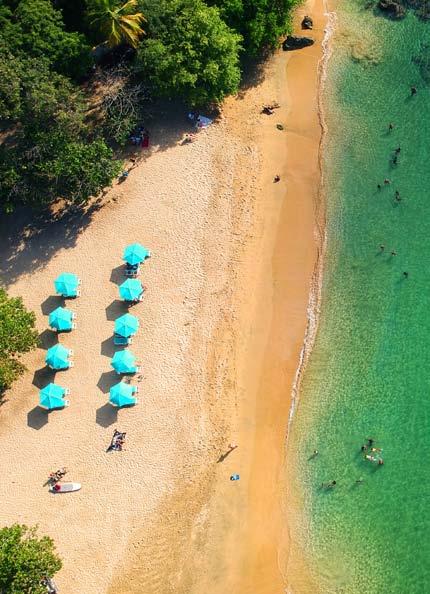
56 round trip where past anD present converge
Explore the stories behind some of the Caribbean’s World Heritage Sites
68 green towarDs More sustainabLe festivaLs
Erline Andrews looks at how Caribbean festivals can become more eco-friendly, and the organisations leading the way 70 on this dAy recLaiMing “papa De koM” Suriname’s great freedom fighter Anton de Kom was born 125 years ago. His work and short, tragic life deserve to be much better known, writes James Ferguson
72 puzzles & brAin-teAsers
80 did you even knoW? Test your knowledge of the Caribbean’s diverse musical traditions
6 WWW.CARIBBEAN-BEAT.COM Contents No. 174 • January/February 2023 50
14
16
38 34
Beat Beat Caribbean Caribbean

An MEP publication
Editor Caroline Taylor
Designer Kevon Webster General manager Halcyon Salazar
Editorial assistant Shelly-Ann Inniss Production manager Jacqueline Smith Finance director Joanne Mendes
Publisher Jeremy Taylor
Business Development Manager, Tobago and International Evelyn Chung
T: (868) 684–4409

E: evelyn@meppublishers.com
Business Development Representative, Trinidad Tracy Farrag T: (868) 318–1996 E: tracy@meppublishers.com
Media & Editorial Projects Ltd.

6 Prospect Avenue, Long Circular, Maraval 120111, Trinidad and Tobago T: (868) 622–3821/6138

E: caribbean-beat@meppublishers.com Websites: meppublishers.com • caribbean-beat.com
Printed by SCRIP-J, Trinidad and Tobago
Caribbean Beat is published six times a year for Caribbean Airlines by Media & Editorial Projects Ltd. It is also available on subscription. Copyright © Caribbean Airlines 2023. All rights reserved. ISSN 1680–6158. No part of this magazine may be reproduced in any form whatsoever without the written permission of the publisher. MEP accepts no responsibility for content supplied by our advertisers. The views of the advertisers are theirs and do not represent MEP in any way.

Website: www.caribbean-airlines.com


7 WWW.CARIBBEAN-AIRLINES.COM
Cover A masquerader, Daniel Bascombe, from Moko Somõkõw’s band “Resurrection at Sorrow Hill”, inspired by Wilson Harris’ novel, and which won Mini Band of the Year in 2019
Photo Maria Nunes
Read and save issues of Caribbean Beat on your smartphone, tablet, computer, and favourite digital devices!


for a comfortable travel experience. Begin your Adventures in Comfort and Style! • Select lounges across our network • Priority check-in and boarding • Date change penalty fee waivers • Discounts at hotels and retailers Enrol or renew your Caribbean Club membership today via our website, call centre or any ticket office.
Shaping the places we’ll always call home

A Messag from our CEO
No matter how far we go, there is an invisible umbilical cord — whether it is our culture, or family and friends we grew up with, or listening to the music of our islands while chipping or dancing through the streets — that causes us to remember the place we grew up in.
After having worked and lived in Europe, Africa, the United States, and Australia, it has been a joy to meet so many people so passionate about Caribbean music and culture — from pan to reggae and everything in between.
I have also met those who left Trinidad & Tobago decades ago, and who are now themselves putting on Carnival events, or playing in a steelband on foreign shores (or starting to). I’ve also met people from all over the world who embrace pan, or fly in to T&T to participate in Panorama every year.

My passion for home was a driving force behind composing the song “My Home”. It asks: what can I do — or what can we do — to build this place we call home? And while for me that is Trinidad, the same question resonates for us all across the Caribbean, and further afield.
“My Home” is primarily an instrumental piece, with a few lines interjecting: Let us work together to secure our future … It is you and me who will shape our own destiny / In a place I’ll always call my home, my own T&T.
The song is intended to invite each of us to wear a lens that helps us better appreciate all the small things that pass us by each day — the things we take for granted, including the talent and phenomenal creativity we have as Caribbean people. If we open our eyes a little more, perhaps we can each make a difference on our own — or together.
“My Home” was later arranged by acclaimed musician and educator Etienne Charles during the Covid lockdowns — to show we can even work across boundaries, utilising the talent and innovation of the steelpan, with players from T&T performing alongside big band musicians in and from the United States.
It is the same kind of energy and collaborative spirit that will help us, at a global level, respond to the threats of climate change. The Caribbean region — along with small island states across the world — is vulnerable to significant loss and damage from severe weather events. We therefore need to turn our minds to adaptation and regional financing for rebuilding, along with efficient use of energy, land, and all natural resources. Clean energy and food security are major priorities as we look to the future.
For me, this is the fundamental message of “My Home”. It calls on us all to play our roles individually and collectively to value and protect all we are, from our people to our natural environment. It’s how we can safeguard the health and vitality of our own home — and to secure the future, both for ourselves and for the next generation.
Mark Loquan is an award-winning composer for the steelpan for over two decades, as well as the founder of the Music Literacy Trust, and Chairman of PanNotation. In addition to his work in the energy industry, he has executive produced a number of video projects, with the most recent being the Women in Pan web series.

Caribbean Airlines #REcalibrated
Trinidad & Tobago — the Mother of All Carnivals

Home to just over 1.4 million hearts beating to the rhythms of calypso, soca, chutney, steelpan, and rapso music, Trinidad & Tobago is the Home of Carnival.
With colonial-era roots dating back to the 18th century, Trinidad & Tobago’s Carnival has grown to become a must see and experience spectacle, and the twin-island republic’s greatest cultural asset.
While the Carnival season culminates on the Monday and Tuesday before Ash Wednesday, festivities start long before, especially after Christmas Day — some say as far back as July, when many mas bands launch their upcoming presentations.
Excitement builds as the frequency of fetes increases; new music is released; and impromptu get-togethers and culinary delights abound. Allinclusive fetes (with virtually unlimited food and drink), and party boat cruises (rides) hold sway. Friends, old and new, come home from all over the world to create memories that will last a lifetime.
The musical fires of calypso, soca and steelpan burn brightest at Carnival time, as tents and concerts burst onto the scene, and steelpan music rings out as orchestras across the nation practise their scores.
At this time of year, Blue Devils make their ways from the hills of Paramin; Sailors and Indian mas take to the streets; and moko jumbies (stilt walkers) deftly weave through dancing crowds.
Calinda-inspired stick-fighting competitions and the re-enactment of the Canboulay Riots of 1881 provide a historical context for Carnival, reminding all of its roots.
More contemporary offerings like Kaisorama, and the Regional and Junior Carnivals — with representations in steelpan, mas, and calypso/ soca — proudly showcase the creativity and individuality of different communities.
Carnival City, at the Queen’s Park Savannah, is the home to many of the season’s events.
Each year, thousands make their way there
10
ADVERTORIAL
to witness the Panorama steelpan competition; the Kings & Queens of Carnival competition; and the Dimanche Gras show, which takes place the Sunday before Carnival begins.
Then it happens. After months of non-stop frenetic activity all across the country, Carnival erupts with J’Ouvert on Carnival Monday at 4am.
Revellers of every walk and stage of life take to the streets, covered in coloured paints, mud, oil, or dressed up in simple or elaborate costumes (or in whatever they choose).
With steelpan and music trucks as the soundtracks for the days’ street pageantry, playing popular and old songs alike, there is even a treat for brass music lovers with the Brass Bacchanal Competition at Carnival City on Monday night.
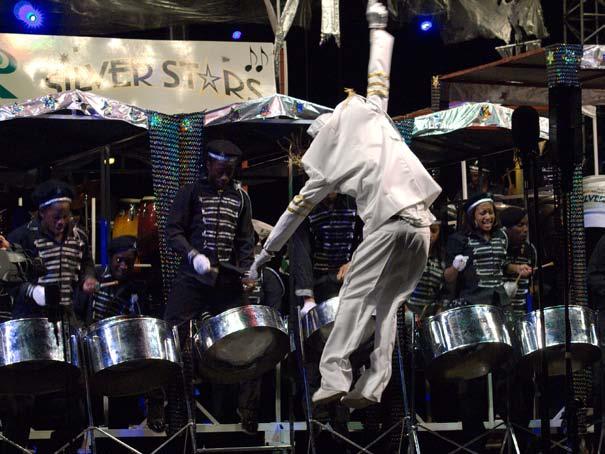
For two glorious days, Monday and Tuesday, mas bands and their masqueraders hold the spotlight. Streets across the nation become the stages of brightly-coloured, moving pageants, all powered by
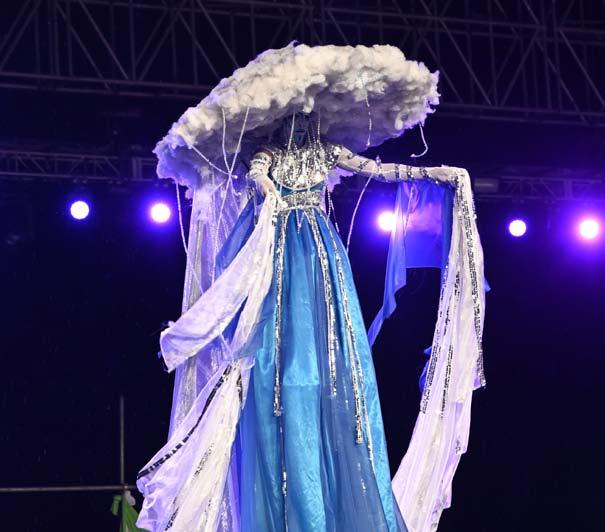

the release of a pent-up energy that has been building for months…and a unity in revelry and celebration.
Carnival is a time of celebration of self and community; of ingenuity and freedom; of past, present, and future.
There really is no experience like it in the world.
Come see for yourself at Trinidad & Tobago Carnival 2023 (Monday February 20 and Tuesday February 21) — the Mother of All Carnivals.
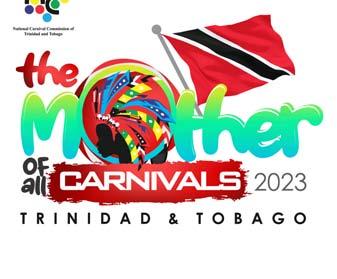

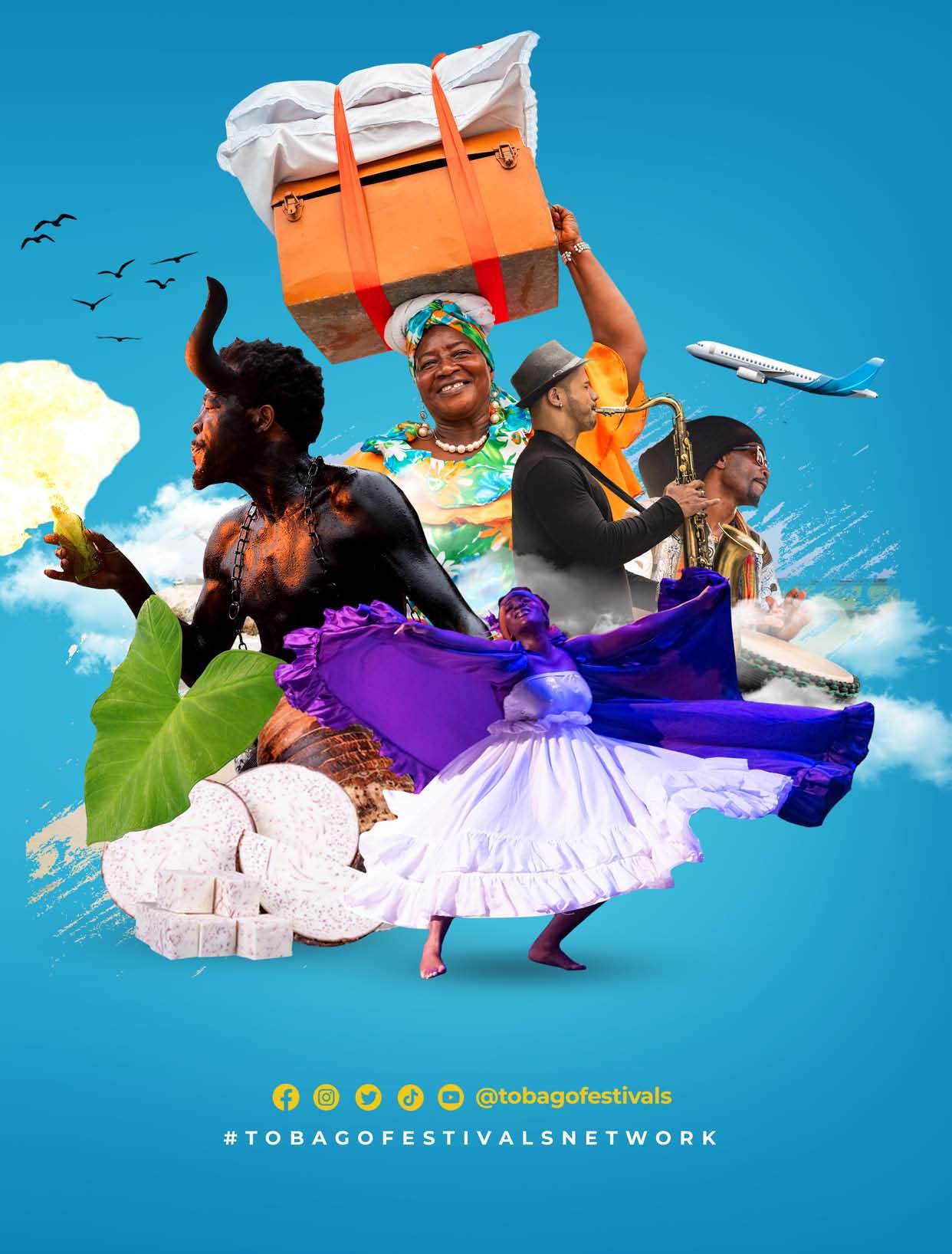
wish you were here

14 WWW.CARIBBEAN-BEAT.COM
the rupununi, guyana
The Rupununi River — a tributary of the Essequibo — lends its name to this expanse of rolling savannahs in Guyana’s southwest, bisected by the Kanuku Mountains. As the new year dawns, sere grasslands dotted with sandpaper trees — named for the texture of their leaves — are a lush green after months of rain. The river and its many creeks, lined by strips of forest, are home to dozens of extraordinary species: from giant river otters to parrots and macaws. Many Indigenous communities of the Rupununi — such as Surama, Nappi, Rewa, and Wowetta — now run their own eco-tourism outfits, hosting visitors in rustic quarters and offering wildlife tours and trekking. And two of the immense cattle ranches established here in the 19th century survive as tourism outposts: Karanambo in the north and Dadanawa in the south, both offering family-style rugged comfort.

WWW.CARIBBEAN-AIRLINES.COM 15
P ETE Ox FORD
event buzz
Essential
info about what’s happening across the region in January and February!
Don’t miss
Jamaica’s capital city Kingston — a UNESCO City of Music — comes to life in an extra special way for Reggae Month each February, with music lovers celebrating reggae’s roots and evolution. The artform was inscribed on UNESCO’s intangible cultural heritage list in 2018, and the annual festivities provide superb opportunities to enjoy live entertainment, films, workshops and public discussions, along with tributes to icons who’ve so richly contributed to the genre. Keep an eye out for up-and-coming talent, too — you’ll remember the experience for a lifetime!

WWW.CARIBBEAN-BEAT.COM 16
M ARC B R ux ELLE /A LAM y S TOC k Ph OTO


17
Festival time
Following the paths of the Maroons at Jamaica’s Accompong Maroon Festival (6 January), visitors can visualise the extraordinary history of these freedom fighters as their descendants commemorate the signing of the Peace Treaty with the British and honour the famous Captain Cudjoe. The day ends with a sound system party continuing to daybreak.
St Lucia’s Nobel Laureate Festival (8–31 January) celebrates national excellence, while paying homage to the country’s two Nobel Laureates — Sir Derek Walcott and Sir Arthur Lewis — with a diverse programme of literary arts, lectures, workshops, and performances.
In Grand Cayman, enjoy a variety of events like cooking demonstrations, wine tastings and creative gastronomic activities at the Cayman Cookout (9–15 January). Meanwhile in Miami, Art Deco Weekend (13–15 January) is a magnet for architecture lovers relishing the city’s vibrant buildings and beautiful façades.
With a large community of Chinese heritage, Suriname vibrantly celebrates the lunar Chinese New year (22 January), including parades to welcome the Year of the Rabbit.
The action is on the water for the Spice Island Billfish Tournament (23–27 January) and Grenada Sailing Week (29 January–3 February), while music lovers flock to the Bequia Music Festival (25–29 January). A range of local and international entertainment will be on offer … as well the island’s laidback charm.
Overlooking the Havana harbour, the old Spanish fortification San Carlos de la Cabaña is transformed into a book extravaganza at Cuba’s havana International Book Fair (3–10 February) — complete with book vendors, poetry readings, children’s activities, art exhibitions, and concerts.
And at the Barbados holetown Festival (12–19 February), celebrants observe the arrival of the first settlers in Holetown. Enjoy showcases of cultural traditions like folk singing and dancing, sports and games, street parades, markets, and food stalls offering traditional Barbadian cuisine.


WWW.CARIBBEAN-BEAT.COM
18
Nicole c o RNW ell, cou R te SY Bequi A Mu S ic Fe S t event buzz
Make mas
Across the Caribbean and diaspora at this time of year, distinctive carnivals — both pre-Lenten ones, and festivities centred around other cultural observances — abound.

Junkanoo, The Bahamas 1 & 2 January
Revellers dance to the rhythms of brass music, horns, whistles, cowbells, and drums fashioned from goatskins and oil barrels.
Mardi Gras, New Orleans (uSA) 6 January–21 February

Spectators vie for “throws” (trinkets like beads and toys) flung into the crowds by revellers riding on decorated floats, while “tribes” of Mardi Gras Indians in costumes inspired by Native American traditions perform traditional dances and songs.
Encarnacion Carnival, Paraguay 28 January–25 February
The Sambadrome and streets are filled for five consecutive Saturday nights in January and February, as five groups and four floats parade in impressive spectacles to batucada rhythms.
19 WWW.CARIBBEAN-AIRLINES.COM G t S P R o D uctio NS /S H utte RS tock.co M
c ou R te SY Vi S itB ARBAD o S event buzz
Carnival of Oruro, Bolivia
16–22 February
Banned by Spanish colonisers in the 17th century, this annual festival was preserved by Indigenous locals under the guise of a Catholic ceremony on the feast of Candlemas. Today, the procession still features elements dating back to medieval mystery plays. Dancers walk the two-mile route and repeat the journey for 20 hours non-stop.
Shakespeare Mas, Carriacou
16–21 February
One of the highlights of Carriacou Carnival (Kayak Mas) is the Shakespeare Mas on Shrove Tuesday, where participants recite lines from the Bard’s plays. But be warned: a mistake warrants a tap from your opponent’s stick! The overall winner becomes the King of Carnival.
Rio de Janeiro Carnival, Brazil
17–25 February
The centre of attention is the Sambadrome and its parade route lined with spectators watching the energetically choreographed procession of samba schools.
Barranquilla Carnival, Colombia
18–21 February
A special four-day holiday infused with a combination of various African, Spanish, and American traditions in dance and music.
Curaçao Carnival 20 February

The signature sound of Curaçao’s carnival is tumba. The main instrument is the drum accompanied by an agan, rattlers, cowbells, and flutes.
El Callao Carnival, Venezuela 20 February
A sea of dancing madamas in African headscarves and traditional wear parade through the streets of El Callao in a fusion of West Indian and French Antilles traditions.
Trinidad & Tobago Carnival 20–21 February
After months of partying, and a range of cultural shows, Carnival devotees let loose for two days of street parades — from J’Ouvert to Last Lap, in “dutty mas”, traditional mas, and “pretty mas”. It’s the climax of the “mother of all carnivals” — powered by soca, calypso, pan… and joy!
Ecuador Carnival
21 February
Traditional Ecuadorian Carnival “games” like throwing flour, water, and spraying foam attract traditional enthusiasts to the small town of Amaguaña, a rural community outside Quito.
Mashramani, Guyana 23 February
The word Mashramani (Guyana’s Republic Day carnival) comes from an Indigenous word meaning “the celebration of a job well done” and features a unique street parade combining patriotic messages with revelry.
Event previews by Shelly-Ann Inniss
WWW.CARIBBEAN-BEAT.COM event buzz 20
O SCAR Chá VE
LAM
z/A
y S TOC k Ph OTO





this month’s listening picks from the caribbean
 Reviews by Nigel A Campbell
Leon foster thomas Calasanitus (Krossover Jazz)
Reviews by Nigel A Campbell
Leon foster thomas Calasanitus (Krossover Jazz)

The steelpan, as an instrument to translate emotion into sound, does not get the high-profile notice that, say, a violin or piano gets. With a history of not yet 100 years, that may be inevitable — but in the hands of a master, one can hear the expressive potential of the instrument. Thomas’ rapid-fire dexterity takes a back seat to his improvisational elan on this, his fourth album, to let his compositions breathe and his guest soloists fly. The album is a tribute to his late mother and her imparted life lessons, and its songs follow a range of ideas and moods — from heartache to joy, contemplation to memory. Steelpan, piano, saxophone and trumpet dramatically converse with each other to tell stories: a parent’s sacrifice, an immigrant’s dream, the migrant’s challenges, a happy evocation of childhood, a meditation on the end of Caribbean life, and more. This mature reflection — both good and sad, all well played — makes this album a keeper.
Monique La chapelle
The Hopeful Romantic (self-released)

The Hopeful Romantic plays like a musical autobiography, or a song diary where personal stories are made public. The arc of a relationship is explored over these seven songs: wishing for love, falling in love, being in love … These nuanced distinctions are reflected in lyrics that speak to her having lived this range of emotions — culminating in the recognition that not all young love is eternal. The decline into and rebound from sadness in this song cycle are completed in a duet with Zachary de Lima, offering a male perspective on the possibilities unfulfilled. Superb production value places this album in a category above many others; playlist inclusion should be a no-brainer. La Chapelle’s vocal phrasing works effectively and emotively on these songs. Fine pop sensibility and a touch of island vernacular on the standout track, “It Doh Matter”, make this a grand debut album from a young Trinidadian singer/songwriter who has something to say.
fay-ann Lyons
The HuU Project: Human Unlimited (Bad Beagle)

There is an open-ended conversation on what constitutes a soca artist. A singer of Carnival songs, a soca singer from the islands, a modern calypsonian? Fay-Ann Lyons is a major soca artist who continues to challenge definitions of the music, bending the accepted rules to create new boundaries for what is possible for soca and modern calypso music in the global marketplace. And her bona fides are top notch too — three T&T Road Marches and a Soca Monarch title. This four-track EP, exclusively done for the Apple Music Home Sessions project and now widely available, has a tantalising diversity of rhythms and producers (Guyana, Ghana, USA) that were used to make this collection widely appealing. Ghanaian producer Kofi Black gives “Over You” an island chill with hints of Afrobeats; his countryman Drillyx Beatz puts a soaring sax on “Island Girl”, making the Antillean metropolitan and cool. Two more jams showcase island music’s future sound.
kevon carter
Welcome Back (XplicitMevon) • Single
...the Carnival spirit saying, ‘welcome back again.’ Those words drive this catchy soca single and define what is said to be the “mother of all Carnivals” in 2023, as Trinidad Carnival will be coming again in full force after a two-year pandemic hiatus. Today we out here looking for more than a taste / ‘Cause we love we Carnival, we love we bacchanal. These lyrics will put a smile on the faces of locals who remember that in 2022, a dull experiment — Taste of Carnival — was tried. To all others, it is an appeal to return to the island since the joy and party atmosphere unique to this festival will be back in full swing. When pop music meets soca, as it has been doing for years, good things can happen. Add Carter’s high tenor pop voice, and you have something better. The synth sound of a reverberating muted guitar dances throughout, giving this track a memorable earworm. This could be an invitation for 2023 and beyond.
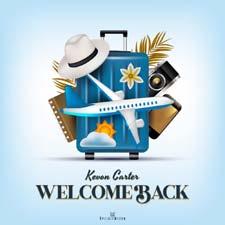
WWW.CARIBBEAN-BEAT.COM 22 music buzz

this month’s reading picks from the caribbean
 Reviews by Shivanee Ramlochan, Book Review Editor
Reviews by Shivanee Ramlochan, Book Review Editor
the Dreaming
by Andre Bagoo (Peepal Tree Press, 168 pp, ISBN 9781845235369)

Gay desire is not new to the Caribbean, and these short stories don’t pretend otherwise. Rather, in Bagoo’s fiction debut, the lives of gay Trinidadian men — closeted, out, positive, negative — are presented with a fullness of human experience. Employing a satirist’s precision, a humourist’s warmth, and a bacchanalist’s passion, the author guides us through one-night stands and symbolic haircuts, down narrative alleyways strewn with Family Planning condoms, polyamorous negotiations, and Nina Simone crooning in upscale Port of Spain coffeeshops. There are men in these stories you’ll want to know, men in these pages you’ll wish you could be: Bagoo’s wry, animate prose is full of the familiar, yet so inventively told that discoveries lurk and limbo in each plot twist. The urban gridwork of T&T is as impressively a character in The Dreaming: the city contains queer multitudes.
the island of forgetting
by Jasmine Sealy (The Borough Press, 336 pp, ISBN 9780008532895)
What happens when domestic drama meets a reinvention of the classics?
Jasmine Sealy’s first novel holds the rum-soaked, cautionary answer: don’t expect an island to be a paradise. Commanding the Greek myths of fabled heroes with virtuosity, Barbadian-Canadian Sealy casts generational waves of trauma, cognitive dissociation, community building, and hard-wrought connections on the tides of her storytelling. In shifting protagonist worldviews, four generations of a haunted family pursue happiness at untenable costs, grappling with spectres of racialised hatred, homosexuality, substance abuse, colourism, and the price of keeping quiet about these and other insidious oppressions. As lushly atmospheric as Tiphanie Yanique’s Land of Love and Drowning, with a freighted fury reminiscent of Nicole Dennis-Benn’s Here Comes the Sun, The Island of Forgetting is both saga and spellbinder.

what a Mother’s Love Don’t teach you by Sharma Taylor (Virago, 432 pp, ISBN 9780349015538)

Dinah knows her son will have a better life the moment he ceases to be hers. Giving up her only child feels like a thorny inevitability: Lazarus Gardens, in all its bullet-riddled criminality, is no place for her own future, let alone her infant’s. As Sharma Taylor’s debut proves with fevered intensity, some threads remain unbreakable despite the cruel vicissitudes of fate. Guiding her novel with a tension-laced economy, Taylor offers a prismatic cast of figures swirling around Dinah and her estranged son. In the voices of gang leaders and snake-tongued statesmen, redoubtable matriarchs and kiss-teeth gossips, the multiple worlds of 1980s Jamaica soar to life, vividly and dramatically realised. What a Mother’s Love Don’t Teach You joins a formidable contemporary canon that refuses to portray the Caribbean as idyllic pastiche. It’s a tender triumph.
what noise against the
cane by Desiree C Bailey (Yale University Press, 96 pp, ISBN 9780300256536)
Ocean, air and earth: all forms of nature are called to bear witness to the Black woman’s journey to freedom in What Noise Against the Cane , a first collection of poems ululating with ventriloquist powers. In the traditions of Lorde and NourbeSe Philip, yet wielding an exploratory lyricism all her own, Trinidadian-American Bailey forges emblems of resistance and rebellion on the page, including “Sea Voice”, the chant of a speaker that runs along the bottom margin of the entire book. The rhythms of Carnival abound here, as does the susurration of sugarcane bristling in the wind: the poet is attendant to these multilayered frequencies, turning her ear to the sounds that generate and animate life itself. As a pivotal poem invokes, we pray that our dead / will not forget the chant below our skins.

24 WWW.CARIBBEAN-BEAT.COM
book buzz
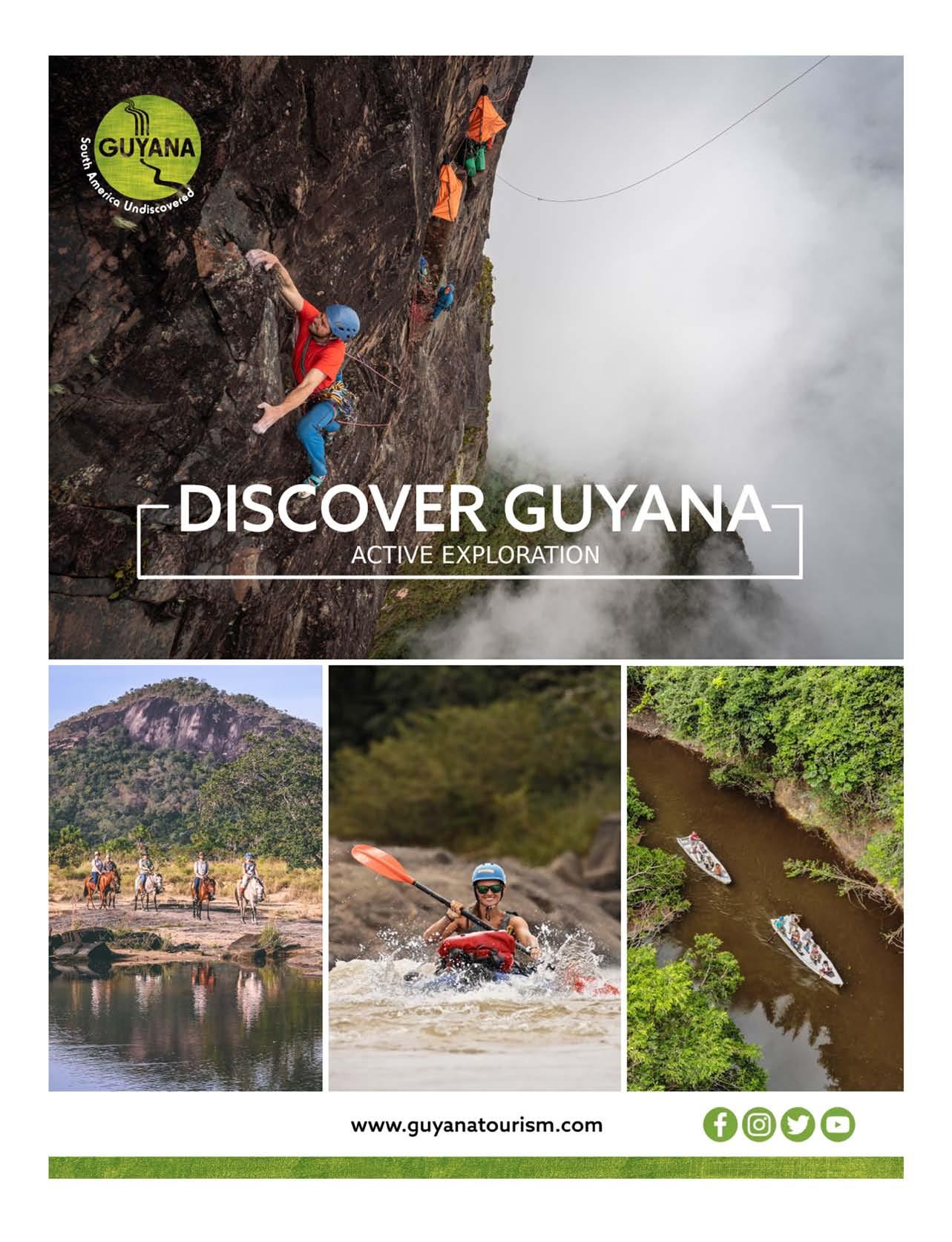
On view: the work of the late Denyse Thomasos
Abstract-style paintings that convey architectural structures — including housing blocks, harbours, scaffolding and more — are hallmarks of the late Trinidadian-Canadian artist Denyse Thomasos’ (1964–2012) work. Thomasos won numerous prestigious awards including a Guggenheim Fellowship, a Canada Council Millennium Grant, a Pew Fellowship, and a Joan Mitchell Foundation Award in painting. And, in Denyse Thomasos: Just Beyond — a career retrospective at Canada’s Art Gallery of Ontario, running until 20 February — more than


70 paintings and works on paper show how she challenged the limits of abstraction, saturating her canvases with issues that were in turn personal and socio-political. Many pieces are being debuted for the first time, and the curators are supplementing the exhibition with sketches, photographs, and newly uncovered documentary footage of her working in studio. A fully illustrated catalogue accompanies the showcase.
Shelly-Ann Inniss
Above Denyse with Babylon in NYc Studio, 2005. © the estate of Denyse thomasos and olga korper Gallery. Photo: Samein Priester
Left Denyse thomasos. Maiden Flight, 2010. Acrylic on canvas, overall: 152.4 × 182.9 cm. Art Gallery of ontario. Gift of Gabrielle israelievitch in memory of her beloved husband Jacques, 2018. © the estate of Denyse thomasos and olga korper Gallery 2018/5
WWW.CARIBBEAN-BEAT.COM 26 art buzz
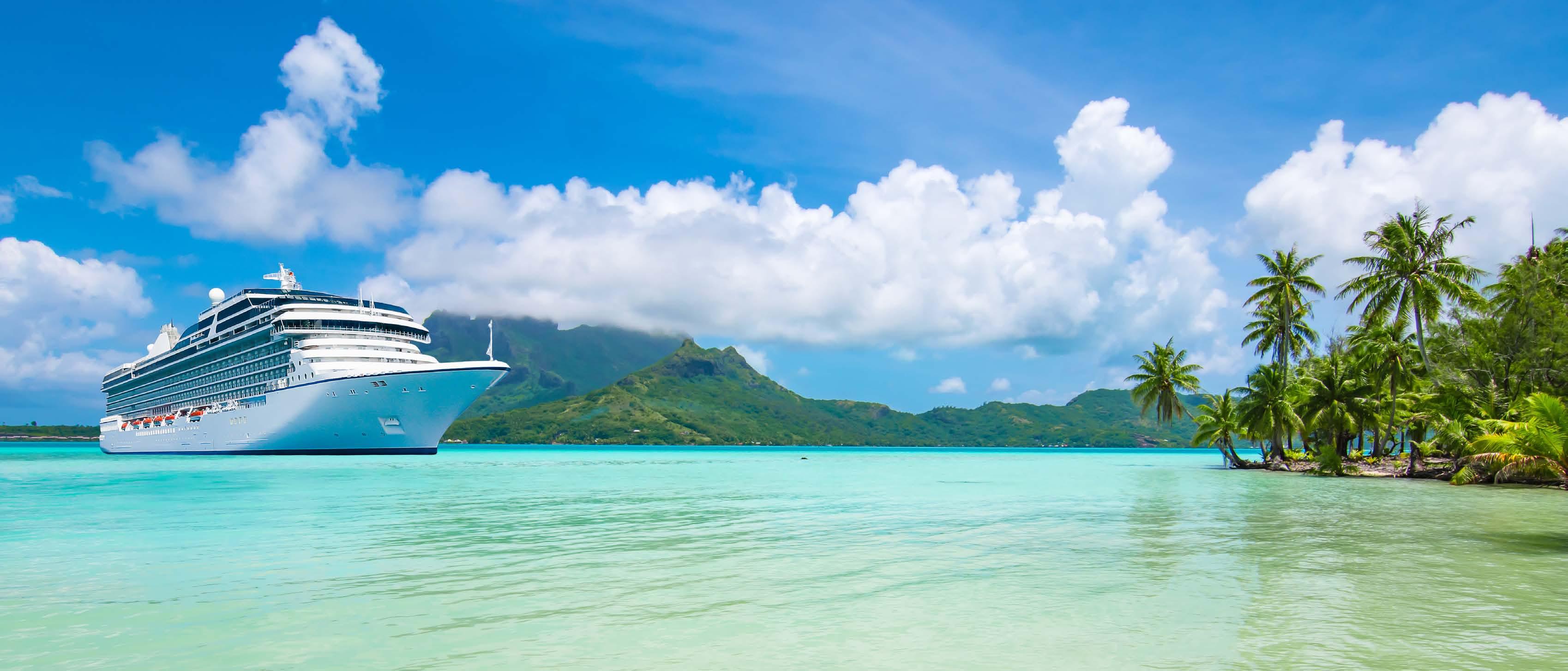






WWW.CARIBBEAN-AIRLINES.COM 27
@ D
W
C H E C K O U T O U R N E W A C C O U N T S
O N T P A C K A P E S T D O N ' T P A C K A P E S T
H E N T R A V E L I N G I N T E R N A T I O N A L L Y
Don’t Pack a Pest is a cooperative partnership between the United States Department of Agriculture, United States Customs and Border Protection, and several state agencies.
Terri Lyons’s calypso favourites
Lessons about history, ethics, poetry, and ways of life are often taught in the lyrics of calypsos. But is an appreciation of rhythm overtaking the value of lyrics in Trinidad & Tobago’s music, as other genres soar in popularity? T&T’s reigning Calypso Monarch Terri Lyons has been singing calypso since primary school. She’s worked alongside prolific songwriters, singers, and producers around the world, and as the daughter of calypso and soca legend Austin “Superblue” Lyons (formerly known as Blue Boy), she considers her father to be her biggest inspiration. Here are her personal top five kaiso classics, and what makes them special.

Fete
by Blue Boy (now called Superblue)
“When most people hear the word kaiso, they think of songs based on social or political commentary. This song, though often labelled as merely soca, combined elements of soca and kaiso perfectly, and definitely brought on a party vibe with it.”
We Could Make It If We Try by Black Stalin
“Upliftment! This is a topic that will always be relevant. This track was released in 1988, and is still played today. It is what I would call a ‘forever topic.’ Somewhere in the world, an individual or an entire nation may need to be uplifted, and this song can do that.”
Corruption in Common Entrance by Cro Cro (also known as the Mighty Midget) “It’s what kaiso is all about — not being afraid to speak on sensitive topics or calling names. This song spoke of issues that our people faced, hence giving a voice to the ones who felt as if their plights were being ignored. Not only is this one of my favourite kaiso songs, but Cro Cro is one of my all-time favourite calypsonians.”
The hammer by David Rudder
“I am fascinated by the way he educates through song. King David Michael Rudder is here telling history through pure poetry in music that will make us dance.”
Gossiping by the Mighty Shadow
“This is one of my all-time favourites simply because it is so unique. This isn’t a topic most writers would think of developing as content for kaiso. Simple and effective. Most kaisonians follow what is trendy, but not Shadow. He always found a way to bring his unique vibe, in effect giving us what we as listeners wanted while mixing it with his own style. Another track that will forever be relevant, since gossip is rooted in Caribbean culture.”
28 WWW.CARIBBEAN-BEAT.COM top five
c ou R te SY t e RR lY o NS








WWW.CARIBBEAN-AIRLINES.COM 29
Duku NOO:
A RECIPE OF INGENUITY
Vaughn Stafford Gray looks at the intuition and resilience built into the history of dukunoo — one of the oldest Caribbean desserts — as well as its cousins across the region and the Americas
In 1996, Enid Donaldson published the “mother of all Jamaican cookbooks”, The Real Taste of Jamaica. For 25 years, it has reigned supreme as the most authentic collection of Jamaican recipes. Not only because it’s by a Jamaican who lived her life on the island, but the dishes are unabashedly rooted in local culture and are not gussied up to appease people who were not from the diaspora.
There are recipes for popular Jamaican desserts in the book’s 156 pages, including one of the best recipes for
sweet potato pudding that I’ve ever tried. Missing, however, is a recipe for dukunoo — a dessert comprised of grated green bananas or plantains, dasheen, sometimes sweet potatoes, cornmeal, nutmeg, and sugar, wrapped and steamed in a banana leaf.

By no means was this a flagrant omission by Donaldson, because many Jamaican cookbooks don’t have a recipe for dukunoo. Why? Not only does it require a bit of sorcery to master, but it is also an indicium of the surviving legacy of Jamaican oral history.
“These recipes are not written down,” said Michelle Rousseau in a 2019 interview. She and her sister Suzanne are Jamaican cookbook authors and restaurateurs. “Caribbean cuisine is an oral, rustic, home-cooked tradition… If these stories and recipes aren’t retained, then the narrative disappears from history.”
Folks can’t even decide on the “proper” spelling of the dish. There’s dukunoo, duckuno and duckanoo
“Language is part of a difficulty with some food of the Caribbean,” says Dr Jessica B Harris in the foreword of her cookbook Sky Juice and Flying Fish: Traditional Caribbean Cooking.
Harris is the Neil deGrasse Tyson of the culinary world. She’s a well-respected culinary historian, author, and soughtafter speaker. Nowadays, due to the Netflix documentary inspired by her book High On The Hog, she’s also a pop culture icon.
“‘What root is what?’ and ‘what do you
30 WWW.CARIBBEAN-BEAT.COM
Ju LIA B OGNANOVA /Shu TTERSTOC k. COM
this sweet dessert consists of cornmeal, grated plantain, sweet potatoes, spices and sugar wrapped in steamed banana leaves
cookup
call this here?’ are two constant questions,” says Harris. “But language is a part of the fun — and Caribbean food is fun.”
Dukunoo originates from the Akan (a Ghanaian language) phrase “doko na”, which means “sweet thing” or “sweet mouth”. Not surprising as the 1.2 million enslaved people taken to Jamaica to fuel the wealth of European empires were brought from West Africa.
It’s also known as “tie-a-leaf” (because the mixture is placed in a banana leaf and tied), and the more saucy “blue drawers” — the blue from the colour the dasheen (taro) gives it, and drawers referring to when underwear was kept up by tying string around the waist.
Dukunoo is one of the few Jamaican dishes, like jerk, that we can trace back to the Maroons. Fun fact: the dish is popular in Cockpit Country — parishes linked by a mountain range to which the Maroons fled. The Maroons used dukunoo and jerked meat as sustenance during their evasion of British enslavers, as it was dense and shelf-stable.
However, discussions of corn-based Caribbean dishes have to include the region’s Indigenous inhabitants. PreColumbus, the First Peoples grew corn, squash, beans, peppers, sweet potatoes, yams and peanuts. West Africans themselves were also familiar with corn and eddoes.
As a trained chef and aspiring culinary historian, I am always eager to find linkages between seemingly incomparable culturally-specific dishes — for instance, Cornish pasties and patties, and paella and pelau
Mexican tamales de dulce (sweet tamales), for example, are made with a variety of nut and fruit fillings. Linking these and dukunoo is the use of cornmeal, the careful wrapping in leaves, and steaming. There are over 100 steps involved in making tamales — almost the same number in making dukunoo.
used to make for her as a small child. I thought this was a prank as I knew no dish called a “Jamaican tamale”. But once she described the unmistakable periwinkle colour and the banana leaf, I exuberantly shouted, “Oh, you mean dukunoo!” Neither of us could contain the excitement of that unexpected cultural connection.
St Lucian-born visual artist and filmmaker Fiona Compton is the founder of Know Your Caribbean, a website and popular Instagram page. When asked about traditional AfroCaribbean dishes and their importance for its people, Compton said, “I believe AfroCaribbean dishes hold a special importance in how we reconnect to our heritage … Our dishes, when we look closer in, are the direct gateway to who we are. They are one of the most tangible and experiential entities that allow us to literally taste what our ancestors did.”
Taking the anthropological approach to heart, I researched which other Caribbean islands have a version of dukunoo.
On a visit to Chichen Itzá in Mexico, I’d taken a phone call from a friend in Jamaica. After saying goodbye, I felt a tap on my shoulder. A young woman asked: “Are you Jamaican?” I hesitated before responding, unsure where she was heading with this.
She asked if I knew the recipe for “Jamaican tamales”, something her nanny
Barbados calls them conkies ; they are made with cornmeal, sugar, coconut, and raisins and are often eaten throughout November to commemorate Guy Fawkes and Independence Days. Trinidad & Tobago calls them paime/payme. In Antigua & Barbuda, St Kitts & Nevis, and St Vincent & the Grenadines, it’s called ducana and is served as an accompaniment to fish dishes. And interestingly, Eastern Caribbean island nations use grated pumpkin in their recipes and no grated green bananas or dasheen.
Whatever it is called, or however it is spelt, dukunoo reflects the ingenuity of a people who had to survive. They found salvation in being deft at developing deep flavour from a collection of bland ingredients that should not work together.

“Whilst our histories have been written from the perspectives of Europeans or not even written at all, our history exists in our food,” said Compton.
In the culinary world, some things get touted, and others erased. The French dessert clafoutis is nothing epic — just another example of bringing whatever is on hand together. But in the pantheon of culinary masterpieces, dukunoo — and tamales, for that matter — would probably never get highlighted when they should be exalted. n
31 WWW.CARIBBEAN-AIRLINES.COM
c ou R te SY Vi S it B ARBAD o S
“Whilst our histories have been written from the perspectives of Europeans or not even written at all, our history exists in our food”
Barbados’ conkie
Mas in the Metaverse… and beyond
Trinidad’s K2K has been innovating with their mas designs since debuting their award-winning medium

Carnival band in 2012. Now they’ve moved into the NFT and metaverse landscape.
Karen and Kathy Norman, the twin designers and investment bankers behind K2K, talk about what this means for mas — as told to Caroline Taylor
our training is in art. so, for us mas is an extension of the ar ts (painting, drawing, storytelling, music, theatre). all our collections are very organic. We use mas as a medium to tell social commentary as well as personal stories. For us, all of our brands are an extension of our lived experiences.
When we were little girls, we were extremely excited to witness Peter Minshall’s costumes in the opening ceremony at the at lanta olympic Games. a s adults, the question we keep on asking ourselves is, how do we continue to elevate, innovate, and evolve Carnival?
d u ring the two-year break due to Covid -19, we had an opportunity to really rethink our strategy. We knew that we really wanted to keep on pushing the brand. We wanted to drive innovation. With K2K’s focus on sustainable fashion through its 365- day Concept, the metaverse and the evolution of digital avenues presented promising new routes for consumer engagement.
While no one quite agrees on how to perfectly define the metaverse, there is no refuting that we are already bearing witness to its potential and the future impact it may have on society. to K2K, the metaverse is the merging of physical and digital realities, which is enabled by various immersive technologies like ar (augmented reality), vr (virtual reality) and Mr (mixed reality). While they are gateways into the metaverse, other pathways exist, which include but are not limited to blockchain technology and by extension non-Fungible tokens ( n F ts).
32 WWW.CARIBBEAN-BEAT.COM
plugin
Photography by Gary Jordan, courtesy K2K Alliance & Partners
At K2K, we believe the metaverse to be an extension of creative identities and digital ownership. It is a platform for commerce, whether that be physicalto-virtual or virtual-to-physical. Ultimately, we believe that the metaverse is a platform for commerce, which will evolve over time.
Our intention is to bring our unique perspective to the digital evolution in two phases. Phase one is the development of a K2K-exclusive avatar to showcase K2K’s collections. For the 2023 collection, garments have been showcased on K2K avatar renderings.
The garments on these renderings can be purchased, highlighting the transition from digital to real-world commercial activity. The intent is to bring these characters from a 3D rendering to an animated form. Phase two is the curation of the K2K-NFT, the world’s first NFT carnival membership experience.
The token-holder obtains access to exclusive social experiences and benefits. The K2K-NFT represents a collection of digital membership passes provided by K2K, and is an evolution of our commerce platform. It is the
convergence of a digital and physical reality.
Many of us know that the NFT universe is known for its digital art component. However, what is the benefit of only having a digital asset when we all live in the real world? As a result, K2K is transforming our digital art into a physical asset.
The collection includes 2,030 NFTs, and is unique in that it transposes digital artwork to a physical garment. The art is showcased on K2K’s 3D rendering of their female-led, minority superhero crew, known as the Havoc Kru. Additionally, there are tangible real-world benefits to be enjoyed through the ownership of the K2K-NFT — unlocking additional value for the token-holder in the physical world. n

33 WWW.CARIBBEAN-AIRLINES.COM
the crowning of Shalom is featured in k2k’s 2023 collection
“LIVING
A DREAM”
It was like if Beethoven was alive and you could go join his orchestra [Phase II]. We look to Len “Boogsie” Sharpe as a living legend.
The very first Boogsie arrangement I experienced was “Pan Army”. My professor had been to Trinidad that year and transcribed all of the music, and the following year he brought it back to Humboldt State [in California], where I had just joined the steelband. I was playing double seconds.
During my time at Humboldt, I played a number of Boogsie’s compositions — “Fire Down Below”, “Birthday Party”, “Pan Rising”, “Misbehave”, “Woman is Boss”, and many more. So getting to come to Trinidad, to be there in the yard in person, and see him create on the spot — being able to be a part of that was living a dream for me.
In the panyard, I had to learn how to do a lot of things that I didn’t learn in school. I had to exercise other skills of my musicianship joining Phase II.
I’ve experienced a lot of sheet music use with other steelbands. Not only does Boogsie not use sheet music, but a lot of times he composes parts on the spot. He’ll change music quickly at the very last minute.

One time I was late for rehearsal, and by the time I got there the whole variation for seconds had been scrapped. When we started running the tune, the band was playing something I hadn’t heard before!
Adaptability and flexibility are definitely characteristics that Phase II requires. It’ll be the night before Panorama and he’s still composing. He might take out the ending. I heard stories in the panyard about when Phase II won with “Woman is Boss” — he was still putting notes in on the track!
The other thing I remember about my first time in Phase II was the overwhelming beauty of the community and the culture in the panyard. The characters,
The magic of Boogsie is that he’ll go to each pan and start to compose their parts. It’s incredible to see someone so virtuosic on every instrument in the steel orchestra.
The other thing stylistically about Boogsie is he has the grooviest melodies but also the most tuneful. It’s not always the most notes, but there’s always a lot of music. And the groove, especially in his background pans, is so hip and funky and cool.

34 WWW.CARIBBEAN-BEAT.COM
the community members, supporters, the players — everyone was so beautiful in their style, their vibe, their love for the music.
Photography by Andrea de Silva
snapshots
American musician and educator Vance
Umphrey on the love of steelpan that brings him to Trinidad Carnival year after year — as told to Attillah Springer
Ray Holman was the very first one to bring an original arrangement for Panorama. Boogsie took on that practice and throughout his entire career he has been composing music for pan
Boogsie is a unique arranger in the steelband community. He is writing for the whole orchestra, he’s not just writing a crazy tenor part and the background is doing whatever. He hears the whole orchestra as one unit — almost like how Bach would play the organ … or like when
he was writing the fugue or toccata for a pipe organ, with all the bass all the way up, all the highs working together.
A lot of the steelbands in Panorama since inception will pick a song that’s already written, and they’ll do a theme and variation of this previously composed

melody. Ray Holman was the very first one to bring an original arrangement for Panorama. Boogsie took on that practice and throughout his entire career he has been composing music for pan.
It’s important in the steelband world to have original music written. When you’re thinking about copyright, you can’t get royalties from your arrangement if you cover, say, Kes’ tune.
Eventually with interventions like the PanNotation site with Mark Loquan and Mia Gormandy-Benjamin, hopefully composers will be able to capitalise on their creative work of original compositions for pan. n

35 WWW.CARIBBEAN-AIRLINES.COM




ADVERTORIAL
SOCA GOLD
In 1973, 50 years ago, there was a dramatic evolution of the calypso — a redefinition of the sound and the business of Carnival music.
Today, Carnival in the Caribbean and across the diaspora has a main soundtrack: soca music. How this music came to define the Caribbean Carnival experience for many, in Trinidad & Tobago and elsewhere, is an exercise of sifting through myth and apocryphal stories, deciphering competitive agendas and egos, and defining a unique space within a global music industry — beyond what Nobel Laureate Derek Walcott describes as the region’s encouragement of “the delights
of mindlessness, of brilliant vacuity”.
New World music — calypso, jazz, rock ‘n’ roll, reggae, hiphop, and dancehall — arises from a community of musicians, singers, and interestingly the media that reports and encourages its development and growth. However, it is sometimes easy to attach one man’s name to the creation and development of new music genres in the Americas — James Brown for funk, DJ Kool Herc for hip-hop, and Antonio Carlos Jobim and João Gilberto for Brazil’s bossa nova.
For soca, a credible case can be made for innovative calypsonian Lord Shorty’s name to be attached to this genre’s genesis, and the song that started it all: his 1973 tune “Indrani”.

Born Garfield Blackman and over six feet tall, his original sobriquet was quite ironically Lord Shorty — but he would later use the name Ras Shorty I, after a spiritual conversion in 1980, until his death in 2000. He ultimately gave the

38 WWW.CARIBBEAN-BEAT.COM
It’s been 50 years since soca music emerged in Trinidad & Tobago.
Nigel A Campbell looks back at the birth and evolution of the music that’s become the soundtrack to Caribbean carnivals around the world
— and continues to seek a commercial life beyond it
c ou R te SY tR i N DAD e x PR e SS Ne WSPAP e RS backstory
sound and rhythm a name, albeit sokah — a journalist’s misspelling shortened it to soca.
He gave the genre’s origin story a persistent, oft-repeated narrative:
The purpose of soca in the 70s … was to bring the East Indians and the Africans together. So, there was a combination of the two main rhythmic structures in Trinidad to create a sound that would be totally Trinidadian … It is not soul as in American soul [music], but the soul of Trinidad, the soul of calypso … It all started with “Indrani”.
The first song that starts a genre is usually identified, in hindsight, by music experts who describe characteristics and instrumentation. Here, propulsive bass over a constant percussive groove with the high-hat mirroring the kick drum, and snare drum syncopating alternately in a tresillo rhythm. It was a musical evolu-
tion in a socially re-awakened Trinidad, as 1970 island turbulence begat cultural pride and inward inspiration for creativity.
Effectively born from a need to update calypso — and hopefully cross over to a wider audience outside the earnest Caribbean diaspora in North America — soca music began to sonically define the Carnival experience from the 1970s, and has continued to through the present.
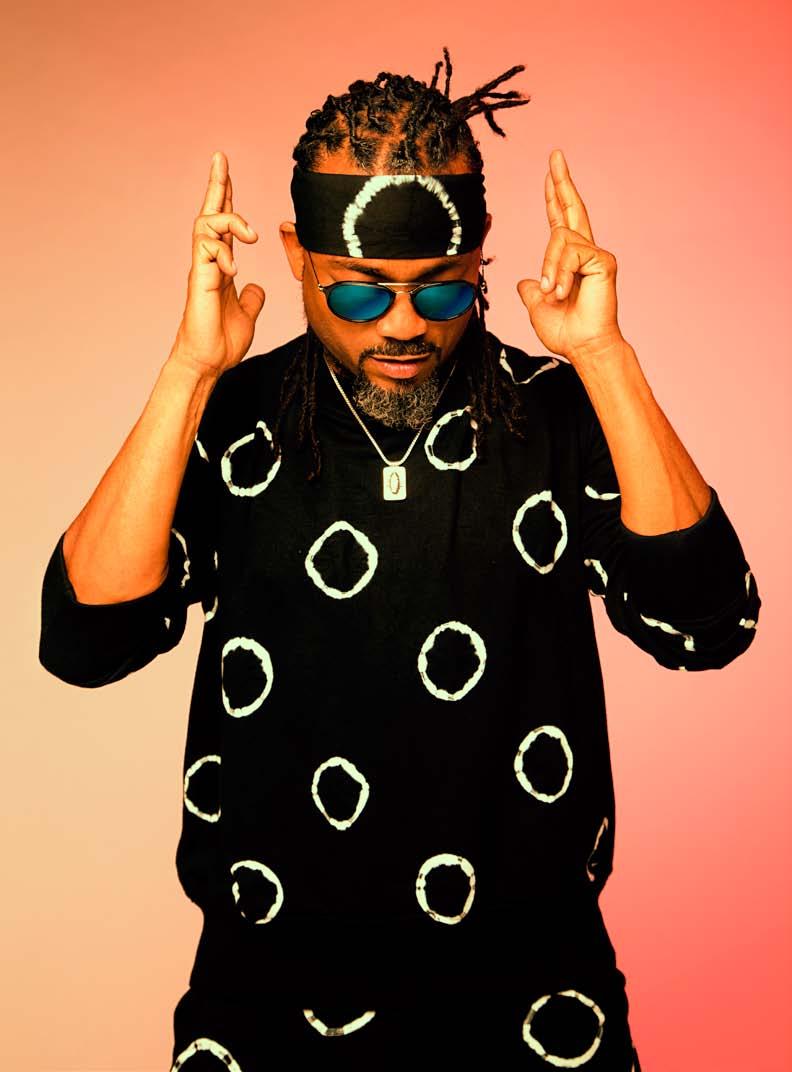
These sole originator stories abound with hyperbole: Little Richard on rock ‘n’ roll (“I say I’m the architect”); or Jelly Roll Morton on jazz (“I, myself, happened to be creator”). Lord Shorty was no different: “I am the inventor, and nobody else”.
Origin stories, however, can be challenged. The names of artists, and the various studio musicians at the important KH Studios in Port of Spain creating that new music in the early 1970s are in the mix for future generations to assign fame or infamy: calypsonians Maestro, Shadow, and King Wellington; and music arrangers Ed Watson, Pelham Goddard, Art De Coteau, and Robin Imamshah.
Soca would become an all-encompassing catchphrase to define music that drove Carnival revellers to frenzied joy. The vibe and energy it provides are addictive and attractive. Despite the initial doubts of longevity and popularity beyond a passing fad, calypso icons soon jumped on board the soca train: Calypso Rose with “Give More Tempo” (1977), Lord Kitchener with “Sugar Bum Bum” (1978), Mighty Sparrow with “Soca Disco” (1981).
Brooklyn, New York became a hub for soca’s global spread in the 1980s, with Caribbean entrepreneurs — Rawlston “Charlie” Charles, Granville Straker, Michael Gould (B’s Records) — doing major business. Other islands picked up on the evolutionary
39 WWW.CARIBBEAN-AIRLINES.COM
cH e k ot HAR i, cou R te SY M A c H el Mo N t AN o
Opposite page the Mighty Sparrow (right) and lord Shorty (Ras Shorty i) Left Machel Montano
sound of soca, which was no longer moored to Shorty’s idea of fusion of African and Indian rhythms.

Antigua’s King Short Shirt with “Tourist Leggo” (1976) forced a xenophobic response to what could be considered a Road March, the most played song on the road: “Not a Trini, no road march”. It mirrored Art Blakey’s famous axiom, “No America, no jazz!”
The Caribbean came forth anyhow. Montserrat’s Arrow has possibly the most widely known soca tune, “Hot, Hot, Hot” (1982). Barbados launched a musical invasion on Trinidad Carnival in the mid-to-late 1990s that changed how the swing of the music evolved; it became groovy
Grenada-born William Munro in 1993 introduced the Soca Monarch competition, dubbed the Superbowl of soca music,
cementing superstar status to a new breed of soca artist: the iconic Superblue, the durable Iwer George, the lyrically skilful Bunji Garlin and his wife the trend-setting Fay-Ann Lyons, and the next generation star — Voice.

In his 40-year career, soca’s biggest superstar, Machel Montano, made collaborations with major artists in other genres a key to his global recognition, pushing the possibility of soca beyond the boundary. As the music modernised in the 1980s — with synthesisers replacing musicians and DJs replacing live bands — international pop began to influence compositions.
Soca mimicked whatever was hot — hip-hop/R&B, dancehall/reggae, EDM, and lately Afrobeats — or boldly interpolateds pop melodies from Enya, A-ha, Cyndi Lauper, The Police, and U2 into soca beats in its quest to break out of the cocoon of
40 WWW.CARIBBEAN-BEAT.COM
Brooklyn became a hub for soca’s global spread in the 1980s … Other islands picked up on the evolutionary sound of soca, which was no longer moored to Shorty’s idea of fusion of African and Indian rhythms
Above Fay-Ann lyons Left Ras Shorty i and musicians
c ou R te SY t o P t ie R M ANAG e M e N t G R ou P
WSPAP e
c ou R te SY tR N DAD e x PR e SS Ne
RS
Carnival festival music, and become the new popular music from hot latitudes, much like reggae and dancehall, bossa nova and reggaeton have done. Even Guyanese music icon Eddy Grant tried to make ringbang — his trademarked facsimile of the soca sound — a hit in the United States, with limited success.
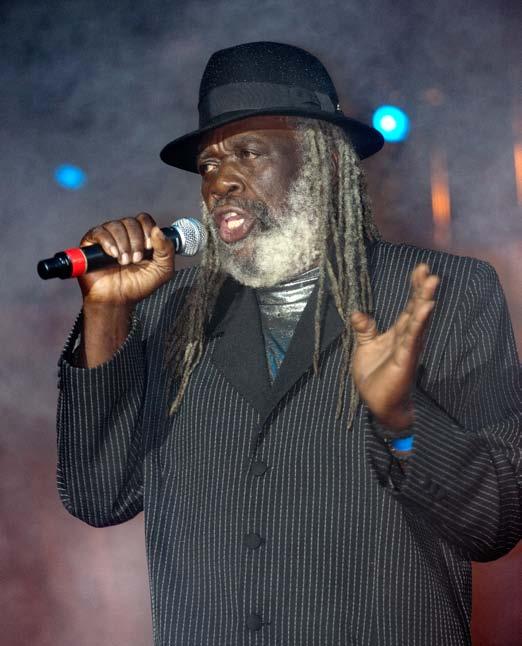
The remix route became the business model for success beyond the diaspora. Vincentian Kevin Lyttle made serious headway into the Billboard Hot 100, peaking at number four with “Turn Me On” (2003); and Barbadian Rupee had his song “Tempted to Touch” (2002) included in a hit movie, moving that song into the Billboard Top 40. A 1987 cover of Arrow’s “Hot, Hot Hot” by Buster Poindexter and Baha Men’s 2000 cover of Anslem Douglas’ “Doggie (Who Let the Dogs Out)” brought US chart success and a Grammy, respectively.
These singular achievements mask the continuing broader struggle for soca to break out into the wider public consciousness beyond Carnival, or in these cases, music for summer up north. On modern streaming services, soca is wilfully labelled “reggae” to get top-tier algorithmic recognition not accorded to soca. The analytics show that reggae/dancehall’s and reggaeton’s popularity, relative to soca, is 10 and 100 times greater, respectively.
Calypso is a lyricist’s and performer’s art, and soca has become a producer’s art. The rise of the “riddim” in the 2010s (one musical bed, many songs — mimicking dancehall’s and early calypso’s economy of production) has generated popular uptake, but limited unique proliferation.
The fete aesthetic rules modern Carnivals. The music is about movement and getting a physical response. Lyrics expressing carnal desires overshadow many soca songs about love, female empowerment, or Caribbean society.
Has soca encouraged Walcott’s “brilliant vacuity”? Not necessarily, as it has also become the driving force to an evolving and diversified Caribbean music industry.
Fifty years beyond “Indrani”, soca is now Caribbean music; artists, songwriters and producers from all the islands reign. St Lucian Dennery segment, Grenadian jab music, Dominican bouyon, Barbadian bashment soca, and more island music genres all exist commercially in the soca space despite their various origins that have nothing to do with Lord Shorty’s thesis of upending calypso’s stasis.
Lord Shorty once said, “Sokah is the power of movement”. He did not lie. The so ul of ca lypso has practically and aesthetically become the s o undtrack of c a rnival, and the constant chameleon-like development of soca means it will be more than that in the future. And we will still be jamming to the beat. n

41 WWW.CARIBBEAN-AIRLINES.COM
c ou R te SY t o P t ie R M ANAG e M e N t G R ou P
Above the Mighty Shadow Left Rupee
M AR k lYND e RSAY
HAVE A SPECIAL POWER WHEN YOU ARE ON STILTS”
Two-time Queen of Carnival Shynel Brizan on how she got into stilt-walking and moko jumbie mas; balancing the demands of Carnival with motherhood; and the experience of winning her second title last year while four months pregnant

as told to Caroline Taylor
So I actually used to box before with a group in Pleasantville, where I’m from. With the coach, we normally used to go on the Wharf and train. He decided he wanted to pass and visit a friend. Lo and behold, he took us on Henry Street to Junior Bisnath, one of the moko veterans.
Anybody he meets for the first time, he always asks if you’re willing to try the
art of stilt-walking — moko jumbie. So he asked us, “Allyuh want to try moko jumbie?” The rest was history … The day after I learnt to walk stilts, I gave up boxing.
I was always a person who likes to try new things. And after trying it, I got to like the feeling — it was a challenge, in a sense, because males are the dominating ones in that field. So it was just me challenging myself to see how good I could be.
Then after performing in different parts of the country and in all those Carnival events, fetes, Soca Monarch, meeting new people, going to different places — I get to “like mehself”! And you feel you have a special power when you are on stilts …
The moko community is always family oriented. Everybody just becomes one. Everybody has a special vibe. They just make you feel comfortable around other people who are doing the same thing as you. They have a better understanding. You know it’s your special place being around those specific people.
In 2012, that was the first time I entered the Kings and Queens competition, and
that was through Junior Bisnath. That’s when I met Mr Alan Vaughan, the designer of Moko Somõkõw. From then we just kept on working on different things … We just clicked at that time, keeping that relationship. And when he moved on to working with Touch D Sky in 2016, I joined. And when he branched off to do his own thing in Moko Somõkõw, I was there.
As a little girl, you see the big mas on the stage for Dimanche Gras. But I didn’t even know the behind-the-scenes and preparing the mas … In 2012, Mr Alan just designed everything and put you out there.
After that experience, I was like, it’s an interesting thing to do ... And then in 2016, I really discovered how good I am at making things, like designing head pieces … He’d draw out what he wanted and give you materials and then you’d have to figure out how to make this drawing come to life!
So he just helped unlock that hidden talent. After that, it just got more and more interesting. I used to dance, and used to look at Broadway and think I want to go and dance there, you know? So I never treat the competition as a competition. I treat it as that time to show off — like I’m on the Broadway stage!
Probably from September to November, Mr Alan and I start talking. We might chat about the theme. We might work out a little sketch of the costume, then mightn’t talk until December, January when he comes back to Trinidad.
Then we stay in Belmont from January ‘til March, back and forth, and have that time with each other. He’ll have his sketch for the headpiece, so it’s just to figure out how I am making this! You never have an
WWW.CARIBBEAN-BEAT.COM
42
c ou R te SY RAPS o iMAG NG
“YOU
own words
—
idea how you’re going to do it … but with the materials, and the vibe … it’s just a flow you have to go with! You just have to trust the process. And you work on the headpiece because that’s the main thing over the next two months. The more you work on it, the more ideas flow.

Then leading up to the competition — the show, for me! — getting ready on the night, painting your face is when the magic starts to happen. You feel like the character starts coming on. Usually, I’ll have an idea of what movements I want to do … we’ll try on the costume at least two times before. I put thought into everything, so I think about what I want to do on stage presentation-wise.
With 2022’s portrayal, I had an extra lot of thinking to do because I was about four months pregnant … You know people will say it’s risky, but I was just doing what I’m accustomed to doing. I wouldn’t just throw up one foot in the air — it would be subtle movement where it would look graceful and be less likely to make me fall. So I thought about the music as it would need to be a little slow, because I’d need to take my time. And then the energy I’d give off — the theme of the costume — is that I’m the “bringer of good things”.
But then on the day of the finals, they wouldn’t let me go on the stage … The rain was falling, so I could understand safety concerns. When I got the call about it, I was doing some last-minute things. Hearing those words — “they won’t let you go on the stage” … I started to cry. Like a baby. People started to post things online, and I know a lawyer got involved …
43 WWW.CARIBBEAN-AIRLINES.COM M ARIA Nu NES
Opposite page Shynel with Alan Vaughan Left 2022 queen of carnival Shynel Brizan portraying “olugbe-Rere ko, the Spirit Who Brings Good things”
But for me myself, I decided I was going to the Queen’s Park Savannah. Still, I started to doubt myself. I was watching the stage, feeling it out … the surface was alright, even though it was wet. One of the dancers was saying the stage was slippery, making me doubt whether I could really do this.
Lisa Fernandez and Maria Nunes came with well-wishes and hugs and were taking photos … and they weren’t looking at me like I was “pregnant Shynel”, but like I was “Shynel Shynel”. Even if they did have concern for me going on to the stage, it didn’t show. And it made me think, why don’t you believe in yourself?
I got to the stage, and I was still a little shaky. But then as the music started to play, I said to myself, “You have this, girl! Do your thing!” I am performing on stage and all that is going on in my head is, “Girl, dance, eh? You’re safe here!”

When I won again, I was in shock … I know I put on a good show, but with everything that happened, almost being disqualified … Getting to be on the stage and performing was the most important thing. Up to this day, I still can’t say how I felt that night.
When I think about when I first won in 2019, I always feel a little bit intimidated because of the size of the other queen costumes. So you’re not really looking to win, in a way. I always think they’re judging for big costumes … So I was in shock then too.

That year, I was on the road Carnival
Monday and Tuesday with my son as a baby. That was my first child and I am in to breastfeeding, so he was always with me in the mas camp, everywhere … So if I’m on the road, obviously I have to feed him! Then people saw us on the road and posted the photos. The positive response was really unexpected.
This year, moving up to Belmont will be different with my kids in school, but I have people who support me, so it will be fine. I’m really looking forward to being on the road … that road action again with Moko Somõkõw. n
44 WWW.CARIBBEAN-BEAT.COM
Right Shynel sits atop the lapeyrouse cemetery wall in Port of Spain to nurse her son Prince
S HA u N R AMBARAN /Met H o D Mo DA
A NDREA DE S ILVA





Call us today The future of business is paperless Let MEP convert your forms to fillable PDFs. Easier for your business clients. Phone: (868) 622-3821, Fax: (868) 628-0639 E-mail: info@meppublishers.com | meppublishers.com
GARVEY’S DISCIPLE

Lennox honychurch explores the life of the late Dominican activist JR Ralph Casimir — an early PanAfricanist, Garveyite, and poet — who is also the subject of a powerful new biography

Caribbean people are very much aware of the contributions of Jamaica’s national hero, Marcus Garvey, for his advocacy of Pan-Africanism and Black pride. Most accounts of Garvey’s life highlight his charismatic personality and inspirational ideas. His tireless campaigning drew a wide following that also came up against prejudice and brutal opposition.
However, this overwhelming focus on the leader has meant that much less is known of the sacrifices made by the rank and file of the movement — the foot soldiers who carried Garvey’s message into the villages and fields of the colonies and raised contributions from across the region to send to the movement’s headquarters in New York.
Now, Kathy Casimir MacLean, a granddaughter of one of Marcus Garvey’s agents in the Caribbean, JR Ralph Casimir
(1898–1996), has written an account of her grandfather’s role in the struggle during the first decades of the 20th century on the island of Dominica. It provides a major contribution to the study of Garveyism in the region roughly 100 years after her grandfather committed himself to the cause.
Like Casimir, most of Garvey’s followers identified with his background among struggling workingclass labourers and peasant farmers on the outskirts of colonial towns and plantations.
Garvey was born in 1887 at St Ann’s Bay, Jamaica. His father was a stonemason and since his family was poor, his education was very sketchy. He left for Kingston at the age of 15 and eventually rose to become a foreman at a printing company. Here he became involved in radical journalism and wrote articles that called on Black people to take pride in themselves and look to Africa as a source of inspiration.
Garvey developed this movement by founding the Universal Negro Improvement Association (UNIA). At first it was a sort of brotherhood organisation, but he later remodeled it to become the main council for Black awakening.
He emigrated to New York in 1916, and the following year founded a branch of the UNIA in Harlem. Here he established headquarters and started a newspaper, The Negro World, which took as its motto the rallying cry of the UNIA — “one aim, one God, one destiny”.
WWW.CARIBBEAN-BEAT.COM 46
Photography courtesy Papillote Press
icon
casimir in 1989
As on many other islands at the time, there existed on Dominica a vibrant core of Garvey activists as his message spread. Led by Casimir, who was a deeply committed and passionate agent of the movement, they strove against great personal odds to fight for change and respect for Black people in this small colonial outpost.
In her book Black Man Listen, published by Papillote Press, his granddaughter paints a loving and well-researched portrait of the challenges he faced. It also gives some insight into the dedication of others like him across the Caribbean at the time who took up the challenge.
The title of the book comes from one of Casimir’s poems of the same name in which he highlights the urgency of the cause, one verse of which reads:

BLACK MAN LISTEN!
You oft quote Marcus Garvey, but Garvey’s philosophy was to educate Build, unite, uplift — Nothing destructive nor reckless. How do you study History? ... Black man has been up and doing for centuries Do likewise: Learn to aspire, unite, create, build.
JR Ralph Casimir was born in the west coast village of St Joseph on Dominica. He was educated at the village school and moved to Roseau, the capital, where he took on various jobs such as bookbinding. He became clerk for the leading lawyer on the island, Cecil EA Rawle — a leading advocate of Caribbean unity, who also campaigned for self-government by increasing the right to vote through constitutional reforms towards universal suffrage.
As Rawle’s clerk, with a deep interest in current affairs and involvement with the island’s newspapers, Casimir became part of an influential group of citizens who were keen to see changes in colonial rule. But even in Dominica there were divisions of class and shades of colour to deal with.




At one point, Rawle threatened to terminate Casimir’s employment because of his involvement with UNIA. According to Rawle, Casimir’s links with Garveyism were giving his chambers a bad name among upper class clients. Calling himself a “New Negro”, for more than half a century Casimir confronted not just colonial rule, but his island’s elites.

These were stirring times in the Caribbean immediately following the First World War, for many young men had volunteered to fight in this imperial conflict. They had been inspired by the propaganda persuading them that, as members of an “imperial family”, it was very much their war.

47 WWW.CARIBBEAN-AIRLINES.COM
casimir with his mother and siblings
casimir’s wedding day
heard the disturbing stories of returnees and began a movement of self-determination that laid the groundwork throughout the 1920s and 1930s for a new spirit of Caribbean nationalism.
ing places such as Panama and Costa Rica, where islanders had
“Liberty Halls” were opened as meeting places. The men and women who led the movement had to maintain momentum, keep spirits up, and encourage membership. At times they had to explain to impatient followers why the idealistic programmes for a Black shipping line, trade, and independent governments were not unfolding as rapidly as they had been inspired to believe.
It was these UNIA team leaders on the ground, such as Casimir, who had to take the brunt of doubting donors when the movement faced its toughest challenges. It was they who had to face the constant questioning as to why the benefits of the subscriptions and shares that they had been persuaded to pay into UNIA were not bearing fruit.
Casimir appealed to Garvey to make a visit to the islands to rally his followers and give them confidence in the cause — as well as to relieve pressure on agents like himself. Kathy MacLean has used her grandfather’s surviving letters, notebooks, and lists of members, along with their financial contributions, to illustrate all of this.

It was into this state of collective consciousness that Casimir immersed himself. Besides his work for UNIA, he served as a secretary for the first West Indies Conference — held in Dominica in 1932 — to plan a union of the Eastern Caribbean. In addition to concerns for regional advancement, Casimir continued to argue for the wider ideals of Garvey’s Back-toAfrica movement. UNIA branches were established wherever





But Casimir soldiered on, backing Garvey’s ideals to the very end of his life, while witnessing a new generation of Caribbean youth inspired by the cause. In Black Man Listen, Kathy MacLean has not only done her grandfather proud, but she has provided Caribbean people with a new window onto Marcus Garvey’s work in the region and among the African diaspora around the world. n

WWW.CARIBBEAN-BEAT.COM 48
“Casimir soldiered on, backing Garvey’s ideals to the very end of his life, while witnessing a new generation of Caribbean youth inspired by the cause”
Above Delegates of the West indian conference held in Dominica (1932) to consider West indian confederation and self-government. JR Ralph casimir (standing, far right) was one of the two secretaries of the conference, chaired by ceA Rawle (seated, third from left)
Right JR Ralph casimir



WWW.CARIBBEAN-AIRLINES.COM 49
Two paths, one Tobago
Tobago is an island of contrasts that offers a range of distinct experiences for visitors. Some like to be in the centre of the action and follow the well-beaten paths to Tobago’s best-known attractions. Others prefer quiet escapes, far from the madding crowds, and as close to being off-grid as possible. Aisha Sylvester introduces both sides of Tobago so you can pick your paradise!

50 WWW.CARIBBEAN-BEAT.COM
destination
Cue the beach-bumming, waterfall-chasing, roadtripping, and night-owling, because the new year has ushered in the dry season and Tobago is calling all lovers of the great outdoors to her shores!
Truth be told, there’s no “wrong” time to visit this southern Caribbean gem. However, in these early calendar months, the island’s greens appear greener, the blues bluer, the water seems clearer, the air feels rarer, and nature generally appears to be showing off … just a little bit. So why not take advantage?
Whether you’re a seeker of off-the-grid serenity, or content with the predictability of the beaten path, here are a few stops to consider adding to your Tobago itinerary.

Beaches
o ff-the-grid
Waveless bays and footprint-less sand go hand in hand here. But, accessing many of these idyllic stretches of coastline often requires a little extra effort.
The meandering North Coast Road presents two particularly enticing opportunities for castaway experiences. Accessible by boat, Moriah’s cotton bay is all calm, clear emerald waters that often remain undisturbed; while a moderate hike (at low tide) will take you to Castara’s Measure bay, a peaceful cove that rarely hosts any visitors.
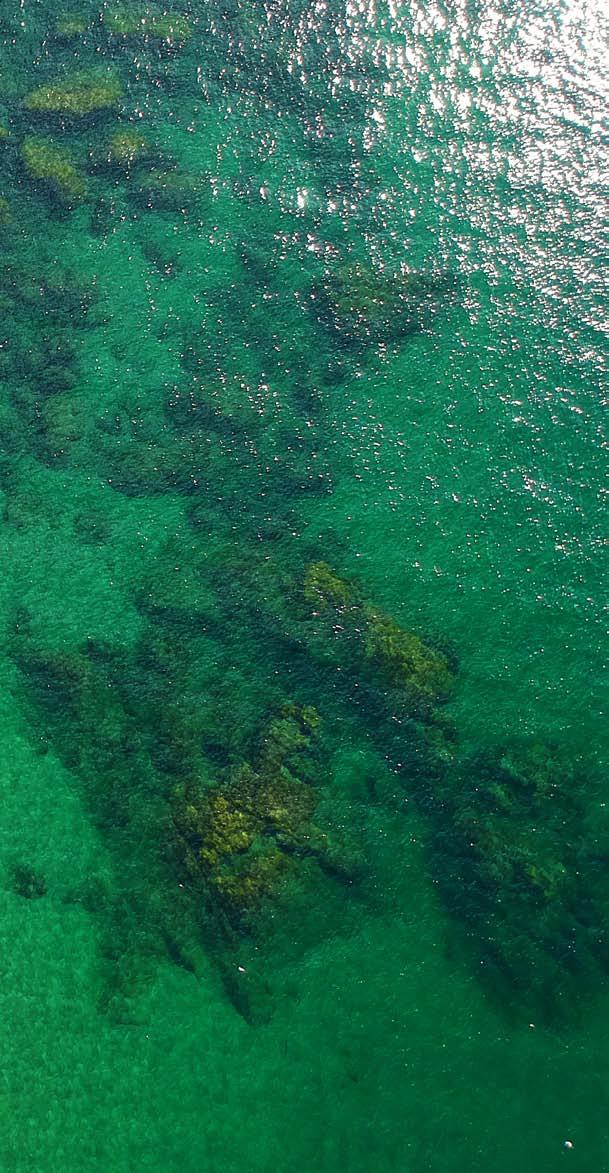
On the other side of the island, the Windward Road serves up two slightly less hidden but equally enchanting options of its own. Speyside’s indian bay, with its black sand and immaculate landscaping, as well as Charlotteville’s ever-popular yet nevercrowded p irate’s bay. Both guarantee gorgeous scenery and favourable water conditions.
t he beaten path
Conversely, those who count beach bars and watersports (and other human beings) as essential elements to a successful beach day are also spoiled for choice. The southwestern tip of the island delivers a range of options that are overflowing with high volumes of traffic and even higher-energy activities.
Whether it’s kite-surfing at the world-famous p igeon point heritage park ; glass-bottom kayaking at s wallows bay ; scuba diving at store bay ; surfing at Mt i rvine bay, or horseback-riding at buccoo bay, you’re guaranteed to find a swatch of coastline where the drinks are flowing, the vibes are nice, and the water is idyllic.
51 WWW.CARIBBEAN-AIRLINES.COM
Mount irvine Beach
C O u RTES y T OBAGO T O u RISM A GENC y
M I k E B RENNAN , CO u RTES y T OBAGO D IVE Ex PERIENCE
Waterfalls
o ff-the-grid
The deeper you venture into Tobago’s lush forests, the grander its cascading falls become. The treks to these watering holes certainly aren’t for the faint of heart (or low on energy). But for those who are thirsting for the challenge, the reward is well worth it.
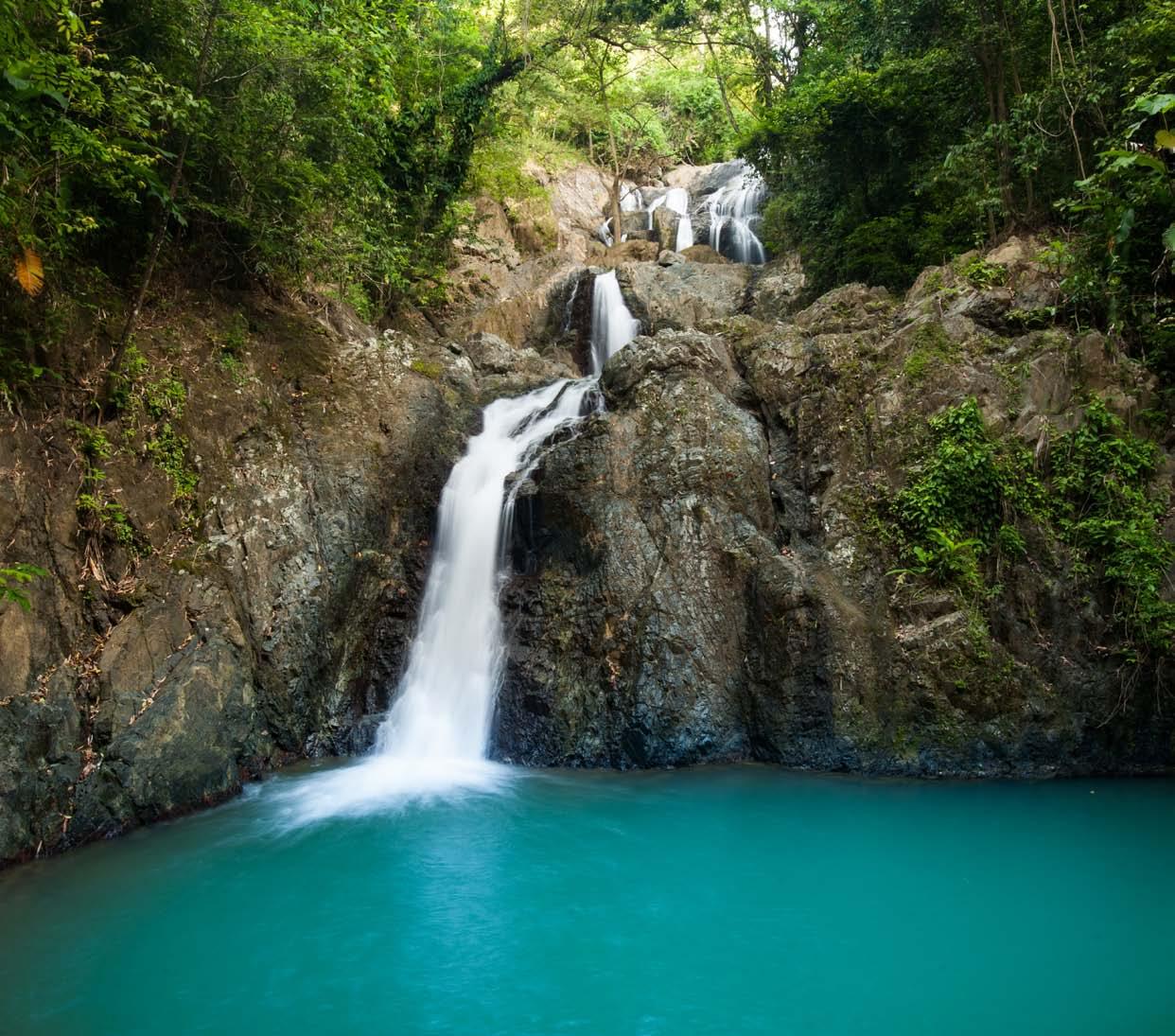
If height impresses you, make the approximately 45-minute hike to h ighland falls in Moriah — the tallest single-drop waterfall on the island. Or, if one pool just isn’t enough, head on over to the village of Pembroke and follow the riverbank to t win r iver falls with its impressive three tiers, the third of which promises a spectacular bird’s eye view of the lower levels and surrounding vegetation — with nary a soul in sight.
t he beaten path
Easy access is a big part of the appeal for some of the island’s most popular waterfalls, but that doesn’t make them any less worthy of attention. Defined trails and flat terrain make these choices ideal for those who prefer gentler forest explorations, as well as for children and families.
Be it a 10-minute jaunt to the modest but majestic single pool of castara waterfall ; a three-minute stroll to the two-tiers at parlatuvier falls; or the 20-minute trek to Tobago’s crown jewel, a rgyle waterfalls, you’ll be more than satisfied with the scenery.
Just be prepared to share the moment with others who are also seeking out this particular brand of water therapy.
52 WWW.CARIBBEAN-BEAT.COM
Falls
J AD D AVENPORT, CO u RTES y T OBAGO B E y OND
Argyle











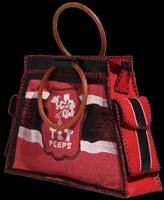

53 WWW.CARIBBEAN-AIRLINES.COM Lowlands Mall, Tobago #15 Ariapita Ave, Trinidad Lowlands Mall, Tobago #15 Ariapita Ave, Trinidad 63-TOOLS (86657) 63-TOOLS (86657) 63-TOOLS (86657) EXT 7065 SHOWING ALL SPORTS LIVE OPEN MON–SUN 8AM–8PM OPEN MON–SUN 8AM–8PM OPEN FROM 8AM MON–SUN OPEN FROM 8AM MON–SUN INCLUDING PUBLIC HOLIDAYS INCLUDING PUBLIC HOLIDAYS Lowlands Mall, Tobago Lowlands Mall, Tobago ALL DAY BREAKFAST ALL DAY BREAKFAST BATTERIES FOR CARS, TRUCKS, AND BOATS FROM TT$488 FROM TT$488 • HOUSEHOLD • HARDWARE • AUTO PARTS • PET SUPPLIES • PERSONAL CARE AND MORE! • Now serving Sushi, Sashimi, Ceviche Authentically Local At the Radisson Hotel, Wrightson Road, Port of Spain 1-868-797-3733 thekuttage thekuttage @kuttage4krafts
Views
o ff-the-grid
You’ll find an abundance of jaw-dropping views of nature’s rich hues along Tobago’s scenic coastal roadways. Fortunately, many remain relatively undisturbed, inconspicuously tucked away off the island’s main arteries.

In the northeast, Mt Dillon presents an uninterrupted vista that stretches several miles to the fishing boats dotting the waters off Castara, while the famous, unnamed bend on the outskirts of the village overlooks a spectacular view of the emerald green shoreline of Englishman’s Bay.
Alternatively, a southeasterly route delivers the deck at i ndian bay, and the lookout point at the entrance to Blue Waters Inn, with their contrasting views of the churning Atlantic Ocean and placid Batteaux Bay. Journey just a few minutes further to Charlotteville and you’ll be treated to the awe-inspiring view of the near-perfect, heart-shaped Man-o-War Bay from f lagstaff h ill
t he beaten path
Some views are so stunning they’re worth taking in even if you have to share the moment with virtual strangers.
Case in point, a visit to Tobago isn’t complete without a stop at fort k ing g eorge to soak up the sweeping 180-degree view, from the old coconut plantations all the way to the island’s capital of Scarborough.

Similarly, a drive northwest isn’t really worth it if you don’t pause to take a mental picture (and a few real ones) of parlatuvier bay from the top deck of the unassuming Glasgow’s Bar, perched on the edge of the cliff just off the roadway.
Nightlife
o ff-the-grid
The term “nightlife” takes on a whole new meaning for those seeking solitude in Tobago after sunset. Just be prepared to get wet.
From night-diving with one of the local dive shops, to glow-in-the-dark kayaking , to stand-up paddle bioluminescence tours, Tobago’s waters don’t close up shop after dark.
However, for those who much prefer to spend their nights on dry land, castara’s weekly beach bonfire is an excellent water-adjacent alternative.
t he beaten path
Tobago may not be a clubbing destination, but it’s got its own brand of after-hours for those who are ready to turn it up once the sun goes down. The Milford Road strip in Crown Point has developed a well-earned reputation as the island’s entertainment hub.
A collection of dine-in and take-away restaurants along with street vendors and bars create an infectious energy that wakes up the otherwise sleepy community in the evening and keeps the proverbial party going well into the early morning hours. n
54 WWW.CARIBBEAN-BEAT.COM
View across Pirate’s Bay towards Man-o-War Bay from Flagstaff Hill
R OBERT
D OWN /A LAM y S TOC k Ph OTO
c ou R te SY t o BAG o Be Y o ND
beyond ordinary...


With secluded white sand beaches lapped by sky blue waters, breathtaking natural beauty, stunning biodiversity and authentic Caribbean hospitality, Tobago occupies a special place in the hearts of all who visit – and we can’t wait to welcome you!
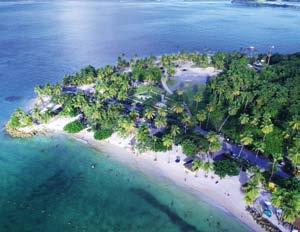
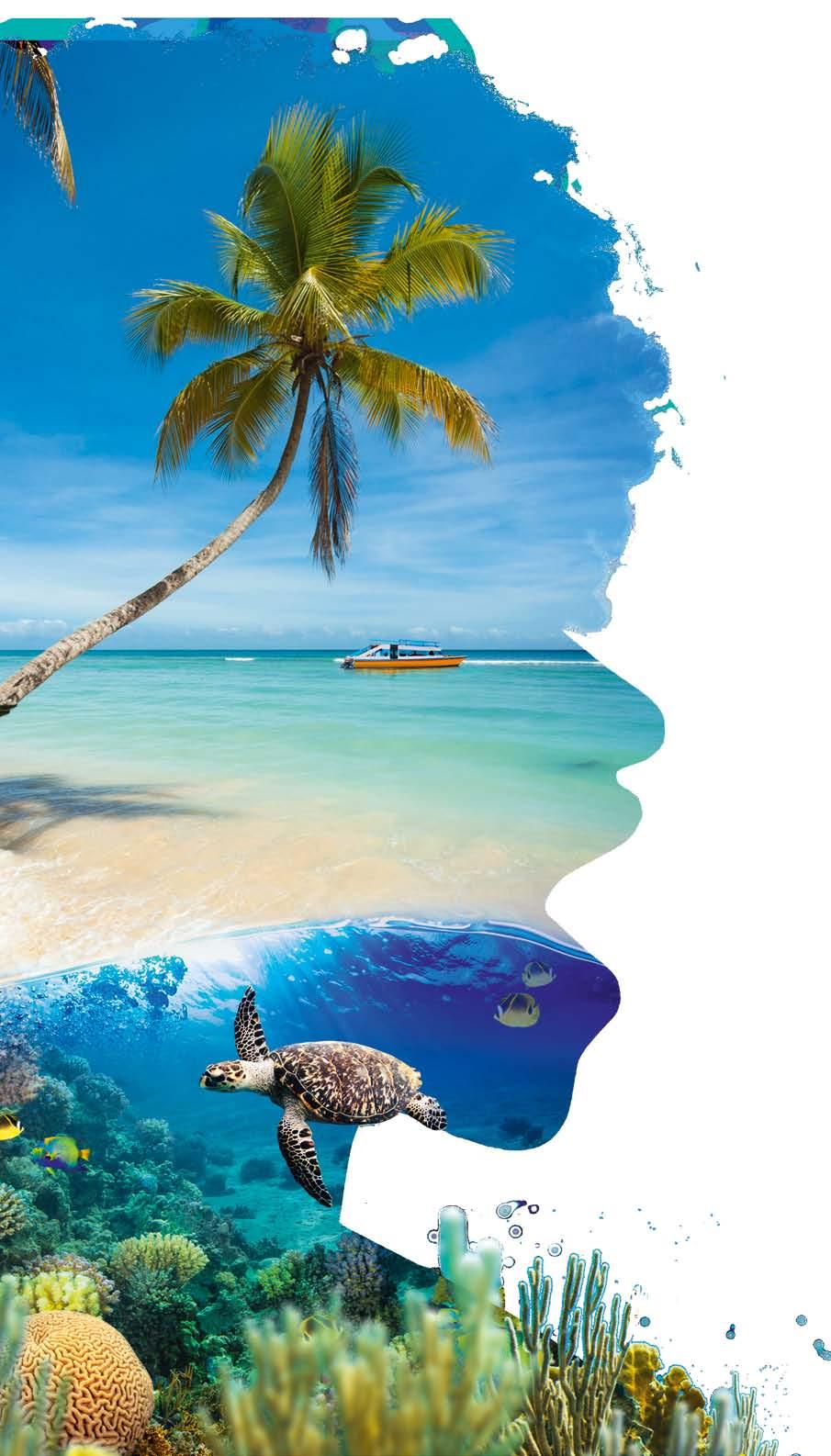
Discover Tobago for your perfect post-COVID-19 escape and prepare to explore our unspoilt, untouched, undiscovered island.



To book a future holiday, visit: BA.com/Tobago You can find out more at: TobagoBeyond.com #101ReasonsTobago
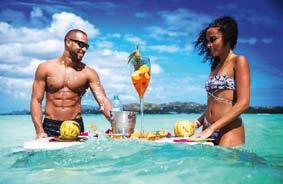
Where past and present converge
Bursting with historical and cultural significance, centuries of stories await among the Caribbean treasures inscribed on the prestigious UNESCO List of World Heritage Sites. Shelly-Ann Inniss shows the way

56 WWW.CARIBBEAN-BEAT.COM
round trip
Viñales Valley Cuba
year of inscription: 1999
Based in the Viñales National Park, the Viñales Valley is remarkable for its karst landscape and mogotes — a series of tall, dome-like hills rising as high as 984 feet from the plains below. Communities here still use traditional, centuries-old methods of agriculture, particularly in the cultivation of tobacco. When you visit, you’ll observe how well the villagers meld and preserve cultural elements from their multiethnic society through architecture, crafts and music. And if you’re in an adventurous mood, a little rock-climbing up the limestone cliffs will enhance the already amazing views.
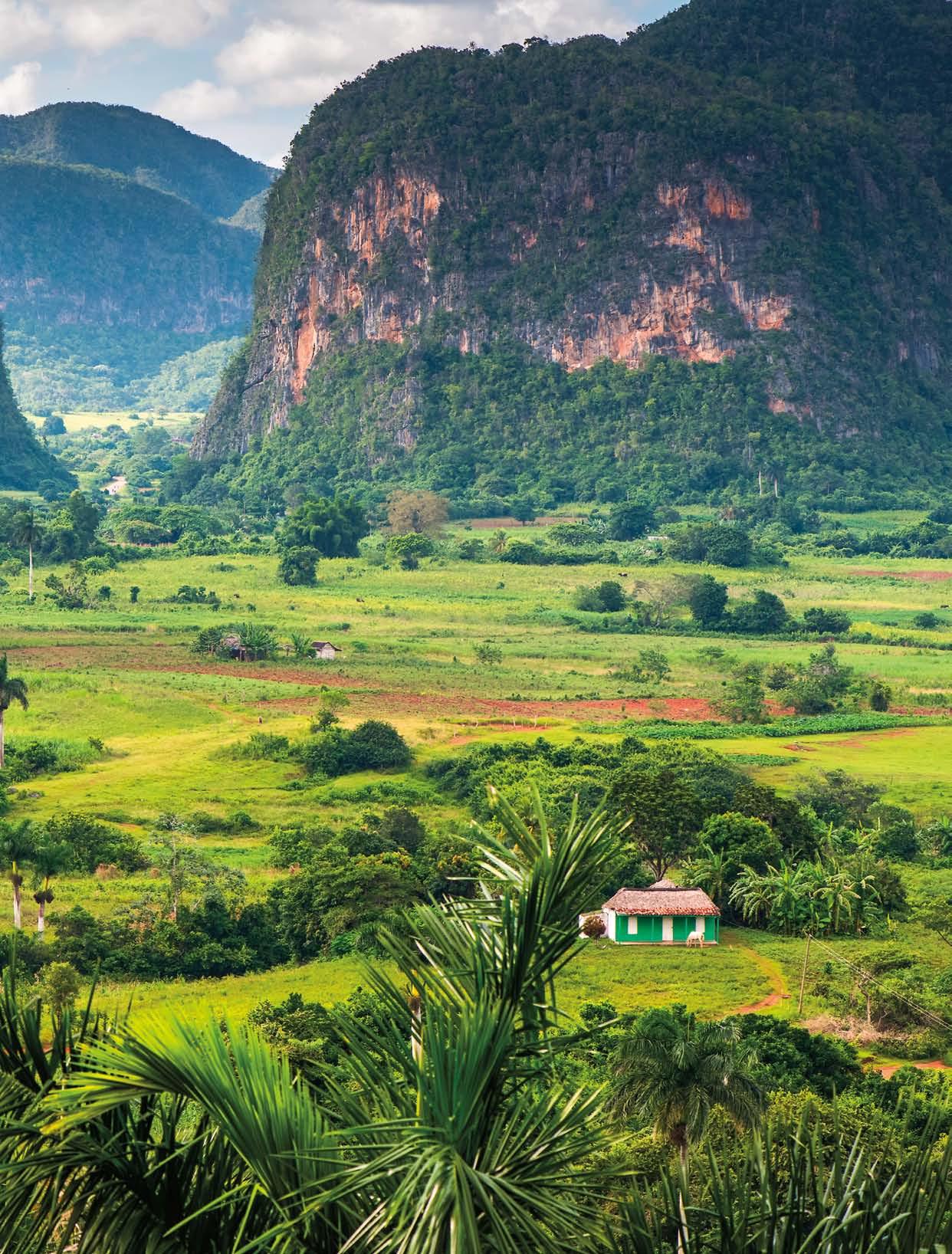
57 WWW.CARIBBEAN-AIRLINES.COM
J u C h A /Shu
COM
MARCIN
TTERSTOC k.
Historic Bridgetown & its Garrison Barbados

year of inscription: 2011
St Ann’s Garrison is the earliest permanent British military base in the Caribbean. Situated on the outskirts of the capital city Bridgetown, the early 17th century path and road network still links the garrison, capital, and port. The garrison has maintained most of its physical attributes, and is among the most intact British garrisons in the world. Be sure to tour the Main
Guard House and Clock Tower, the Barbados Museum and Historical Society, St Ann’s Fort and the military hospital, and George Washington House — the former residence of the first president of the United States. Time permitting, a journey into the heart of Bridgetown to see Blackwood’s Screw Dock and Nidhe Israel Synagogue and Museum are a must.
58 WWW.CARIBBEAN-BEAT.COM
Fili P Fux A /Al AMY Stock P H oto




Antigua Naval Dockyard & its Related Archaeological Sites
 Antigua & Barbuda
Antigua & Barbuda
Year of inscription: 2016
The deep waters of English Harbour, along with narrow bays and mountains, protected the royal naval fleet against hurricanes and attacks in the 18th century. What better location for the king’s naval yard? The Georgian-style naval buildings and structures of Nelson’s Dockyard (renamed after its restoration in 1950 in honour of Admiral Horatio Nelson) still have original features like a small bakery dating back to 1772, which contains three ovens that once supplied the compound with fresh bread. The 1789 Copper and Lumber Store, now a hotel with the same name; Nelson’s living quarters (currently serving as a museum); and the iconic pillars that supported the Boat House and Sail Loft are also attractions.
60 WWW.CARIBBEAN-BEAT.COM
Roy Johnson/Al A my s t ock Photo

61 WWW.CARIBBEAN-AIRLINES.COM
The Historic Area of Willemstad, Inner City & Harbour Curaçao
year of inscription: 1997
The distinctively-coloured buildings of Curaçao’s capital, Willemstad, bear signs of the country’s Dutch architectural heritage — but also of Spanish and Portuguese influences as a result of 17th century trade. The colourful buildings became a local tradition as far back as 1817 when the previous white lime finish was prohibited, to protect eyes from the sun’s glare. The
main colours now are red, blue, yellow ochre, and green. Another distinctive element commonly found in two of Willemstad’s historic districts (Otrobanda and Scharloo) is the Curaçao Baroque style of architecture where a predominant characteristic is the curved Dutch gable, as seen in the Penha Building (1708, pictured).

62 WWW.CARIBBEAN-BEAT.COM
G A il Jo HNS o N /S H utte RS tock.co M

Historic Inner City of Paramaribo
Suriname
year of inscription: 2002
Located along the left bank of the Suriname River, the historic inner city of the country’s capital comprises distinctive wooden buildings that blend Dutch architectural styles with Creole and North American influences. By the end of the 18th century, the Dutch infrastructure enabled the town to be extended over marshland, but there are no highrise buildings here. Instead, there are 291 listed monuments, with most also demonstrating use of traditional techniques and materials in repair and rehabilitation works. Check out Fort Zeelandia (1667); the Presidential Palace (1730), built with stone and featuring a wooden upper floor; the Ministry of Finance (1841), a monumental brick structure with classical portico and clock tower; and the Gothic Revival Roman Catholic Cathedral (1885, pictured), built with wood.

64 WWW.CARIBBEAN-BEAT.COM
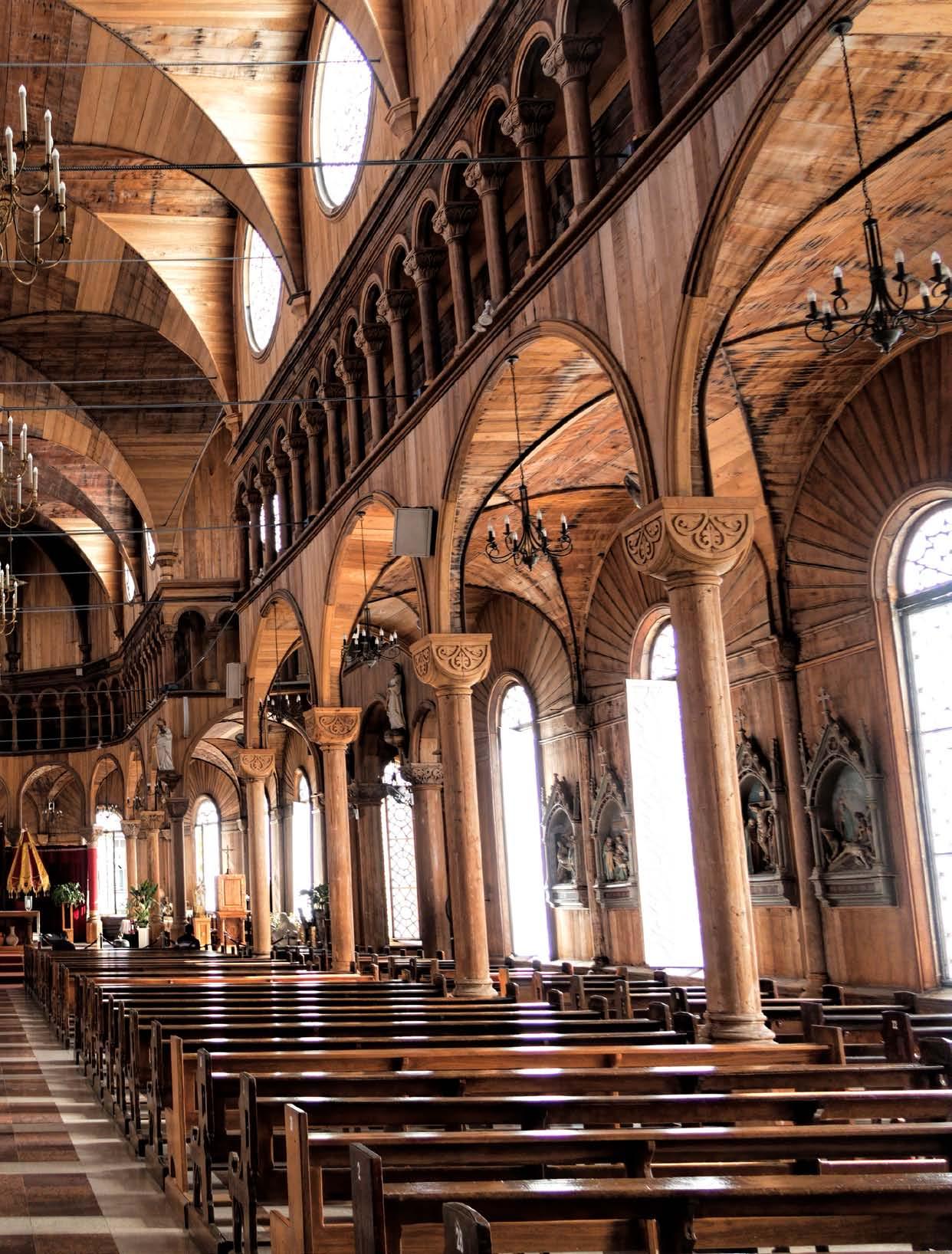
65 WWW.CARIBBEAN-AIRLINES.COM D AN Lu NDB u RG CO u RTES y FLIC k R
CARIB BREWERY PARTNERS WITH STEPHEN MARLEY TO CREATE ROCKSTONE TONIC WINE.




































CARIB Brewery has partnered with musical icon Stephen Marley to create a future beverage icon; Rockstone Tonic Wine. It’s the first Tonic Wine with POWAROOTS™; a powerful mix with Horny Goat Weed, Maca Root and Bois Bande that helps you “Reach the Longtime”.
After meeting through a mutual friend, Stephen and CARIB decided to partner on a Tonic Wine he would be proud to endorse. They noticed an increasing demand for drinks that were smoother and better tasting yet still strong and affordable. It was a golden opportunity to combine two worlds: a tonic wine potent enough for young guys yet surprisingly smooth.



Working with branding agency Thirst Craft, they named the tonic wine Rockstone after Stephen’s iconic song. The sleek bottle with its stunning gold cap was designed by world-renowned design agency Brandology. Canadian ad agency Berners Bowie Lee created a launch campaign featuring music from Banx and Ranx. The brand will work with some of the Caribbean’s hottest Dancehall Artists and acclaimed US Director Gil Green in the new year. So far, Rockstone has been a massive hit. CARIB isn’t surprised. They were confident that the combination of POWAROOTS™ and the smooth taste would be a winner. As CARIB Brewery Category Manager Antron Forte says, “For Rockstone, the party’s just getting started. We’re ready to Reach The Longtime ourselves”.

IT’S A GAME CHANGER FOR THE CARIBBEAN, AND OUR CULTURE.
I WANTED TO CREATE A TONIC WINE THAT I WOULD DRINK MYSELF. SOMETHING A LITTLE MORE SMOOTH AND MELLOW WITH A REAL POTENT KICK. —STEPHEN MARLEY ADVERTORIAL
“ “

TOWARDS MORE SUSTAINABLE FESTIVALS
tance of making the festival sustainable.
After starting with the Jamaica, Barbados, and Miami carnivals in 2019, 2020 was the first time Carnicycle operated in T&T. Based on what was deposited in collection bins placed across the islands, Mcletchie and Harris realised J’Ouvert contributes a lot of the estimated 7,500 pounds of waste generated by Carnival every year.
Tobagonian Danii Mcletchie, a 20-something environmental expert, loves J’Ouvert. The early-morning party-parade, which kicks off Trinidad & Tobago Carnival, is her favourite part of the festival.

“You come as yourself. You can dress up, you can dress down. You come as you want to. Nobody looking at you. Nobody judging you,” she raves. “Carnival is freedom, liberation, happiness. And I think J’Ouvert is the epitome of that.”
It seems fitting that an environmentally and socially conscious person prefers J’Ouvert — where masqueraders
often cover themselves in mud, paint and oil — to the parade of extravagant and expensive costumes seen on the second day of Carnival.
On the surface, it seems like J’Ouvert is more sustainable. Unfortunately, this isn’t the case.

Mcletchie and high school friend Luke Harris in 2018 co-founded a company, Carnicycle, to collect and rehabilitate used Carnival costume materials — mainly beads and feathers — and resell them at reduced prices. They also sell fashion accessories like handbags and earrings made from the collected materials. They work to educate people about the impor-
“J’Ouvert bands will print t-shirts and bodysuits for people to wear, and some people wear them once and then just toss them away,” explains Mcletchie. “We were surprised to see all the shoes in [the bins],” she said. “If you’re a foreigner you probably don’t have time to clean your shoes, and you’re not taking back dirty shoes with you. It makes sense, but it wasn’t something we thought of initially.”
Trinidad & Tobago’s carnival is one of the most influential in the world, probably only second to Rio’s in terms of reach. It has spawned more than 100 copies across the globe. This includes North America, Europe and Asia. The most recent Trini-style carnival was founded this year in Bali and took place over six days in September.

68 WWW.CARIBBEAN-BEAT.COM
With their ephemeral nature and reliance on a great number of “single use” materials,
Ste V e N lASRY , cou R te SY uNSP l ASH
green
Erline Andrews looks at how Caribbean diaspora festivals can become more environmentally sustainable — and at some of the organisations leading the way
The carnivals are essentially costumed street parties with masqueraders dancing to soca and steelpan. Fetes and other cultural activities lead up to the
Over the two days of Carnival more large crowds gather around T&T than at any other time of the year. More visitors arrive than at any other time. More disposable containers, cups and utensils are used and discarded. More drinks and snacks in plastic, glass and aluminium packaging are consumed.
At a seminar co-organised by Carnicycle in 2020 about making Carnival sustainable, it was disclosed that 52 materials used to make Carnival costumes were harmful to the environment.
If any event needed an injection of environmental consciousness, it’s Carnival.
Mcletchie and Harris hope that the influence of the T&T carnival means a sustainability movement started here will spread to the other carnivals.
“Carnival is a global event. Trinidad’s carnival is supposedly the greatest show on earth. How is it the greatest show on earth if you’re causing harm to the environment?” Mcletchie said.
“CEPEP [the Community-based Environmental Protection & Enhancement Programme, a state agency] does its best to clean up the street during the parade,” she continues. “But the truth is there’s a lot of waste that does not end up in the landfill. Where does it go? It goes in the

drains and then it goes into our oceans and it’s damaging the environment.”
Carnicycle — which recently became a non-profit — works through various corporate and NGO partnerships. For instance, the collected clothes and shoes were cleaned by industrial washing machines and dryers at the Hyatt Regency, where a collection bin was placed during and briefly after Carnival.
Clothes and shoes were donated to the charity Barters for Babies for distribution to the needy.
Perhaps Carnicycle’s most important partnership so far is the one it has formed with Tribe, the largest mas band in T&T. There was a collection bin in the band’s mas camp in 2020. This past August, Tribe donated 300 excess costumes to Carnicycle.

The 17-year-old band had previously taken action to reduce its environmental impact. In 2019, it switched styrofoam food containers and cups for compostable alternatives. That year at its annual Ice Fete, it didn’t offer plastic straws and provided collection bins for recyclable products.
A Tribe spinoff band started in 2015 — The Lost Tribe — doesn’t use feathers and uses materials and designs that make it easier for the masquerader to reuse parts of their costumes. The Lost Tribe won large Band of the Year in 2019. Its success opens the possibility that other bands might adopt its approach.
Carnicycle interviewed Lost Tribe designer Atiba Borde for its blog: “The band has become a featherless band — prohibiting the use of feathers in designs. This allowed designers like myself to be more sustainable and creative when procuring materials,” said Borde. “I try to replicate this way of designing when designing for other bands. I also try to create designs that masqueraders would want to incorporate into their wardrobe so that the costume is not a single-use piece.”
It’s an approach similar that of K2K Alliance & Partners, a medium-sized band founded in 2011 that has copped the Band of the Year title in their category several times. They launched the band with a “365-Day Concept”, encouraging masqueraders to use their Carnival costumes well after the season, for many years to come.
Mcletchie would like to see all bands adopt a sustainable approach to how Carnival costumes are designed and constructed, and the materials used.
“Costumes the way they are currently designed are really for one-time use. What we call fast fashion. There is no current reuse of costumes from last year to the next year,” she said.
Carnicycle for now is looking to partner with other Carnival bands in collecting discarded costumes.
Sustainability would eventually benefit everyone, Mcletchie said.
“It’s cheaper to the band to not have to pay these costs year after year because they’re reusing things,” she said. “And ultimately we hope it can be cheaper to the people who are playing mas… Our end goal is to make Carnival not just environmentally sustainable, but also socially sustainable so that everybody can feel like they have a place in Carnival.” n
69 WWW.CARIBBEAN-AIRLINES.COM
c ou R te SY cARN cY cle
If any event needed an injection of environmental consciousness, it's Carnival
RECLAIMING “PAPA DE KOM”
Suriname’s great freedom fighter Anton de Kom was born 125 years ago. His work — including We Slaves of Suriname, which has recently been published in English — and his short, tragic life deserve to be much better known, writes James Ferguson

“H
ow much do you know about Suriname?” The New York Times asked its readers this recently, challenging them to identify the country on a world map. The country is often, it seems, mistakenly placed on the wrong continent. Travel writer Simon Romero recounts how a South American correspondent phoned his editor at a reputable London newsroom to announce his arrival in Paramaribo, the country’s capital. “What the hell are you doing in Africa?” growled the editor.
Myth and mischief have served to sow confusion over Suriname’s identity as well as its whereabouts. Arthur Conan Doyle’s The Lost World (1912) imagined the Guianas — comprising Suriname, Guyana, and the French overseas department of Guyane (French Guiana) — as a primordial throwback where dinosaurs roamed, while the deservedly forgotten adventurer Nicol Smith came up with a travelogue in 1941 which promised an “authentic hair-raising account of voodooism, wild adventure, three-fingered men and tropical terrors”.
Leaving aside sensationalism, there is some reasonable uncertainty as to where Suriname fits into a Caribbean context. Its official language is Dutch, but it is a member of the majority English-speaking Caribbean Community (CARICOM). It is not bordered by the Caribbean Sea — but then neither is Guyana, which is unmis -
takably Caribbean. It sits on the northern tip of South America but has little in common linguistically and culturally with Latin America. And it looks more towards the former colonial power, the Netherlands — where some 350,000 people of Surinamese descent now live — than the United States.
So is Suriname a Caribbean country? I think a sensible answer lies in the work of
In this sense, everything that makes Suriname unique is a result of this plantation past. Its famously diverse communities of African, Indonesian, Indian and Chinese descent reflect a history of slavery and imported labour from the Dutch Empire. Its wild interior is home to Maroons (descendants of those who built new communities after escaping the plantations), while the exquisite Dutch architecture in the historic district of Paramaribo is the legacy of the departed planter class.
The plantation-dominated past that Suriname shares with the wider Caribbean is vividly brought to life in a “new” book, just published in the United Kingdom by Polity. Books in English on Suriname are rare, and this one — We Slaves of Suriname — is a gem.
the late Trinidadian economist Lloyd Best, who formulated the concept of the “plantation economy” to analyse the history of the Caribbean region. He explained how the colonial powers created slave-based plantation economies, then replaced slaves with “free” or indentured labour, and then withdrew — leaving independent but underdeveloped countries dependent on exporting commodities.
First published in Dutch in 1934, it was written by a Surinamese named Anton de Kom, who was born 125 years ago on 22 February 1898. De Kom is not widely known outside Suriname and the Netherlands, where he was forgotten until quite recently. But his work, and his short and tragic life, deserve to be much better known.
De Kom was born in a poor district of Paramaribo, his father enslaved at birth and his mother the daughter of a freed slave. He was clearly a bright boy as he acquired a diploma in accounting and joined a Dutch company exporting balata
70 WWW.CARIBBEAN-BEAT.COM
Photography courtesy Wikimedia Commons
on this day
(a rubberlike material) to Europe. But his memories of school were of a “white history” syllabus, which systemically created a sense of inferiority among the non-white children.
His Dutch-centred education and the treatment of labourers in the balata plantations fired a sense of injustice, and de Kom became a radical anti-colonialist. After a brief sojourn in Haiti, he sailed to the Netherlands where he eventually found work in The Hague with a coffee importer. He also made contact with anticolonial activists from other Dutch territories such as Indonesia, and was close to communists and other radical groups.
These encounters confirmed two key aspects of his political outlook: profound opposition to Dutch imperialism and an understanding that people of all ethnicities around the world were victims of this imperialism.
In January 1933, de Kom returned with his wife and four children to Suriname, hoping to start a new life. But he was already under surveillance by the colonial authorities as a known agitator. Barred from holding meetings, he acted as an informal consultant in his father’s house, listening to the grievances of poor
people from all backgrounds and promoting community action.
When in February the police dispersed a gathering, a crowd marched to the Governor’s palace and de Kom was arrested. Five days later, police fired into a crowd of demonstrators, killing two and injuring many more. Fearful of the influence of the popular “Papa de Kom’’ among the poor, the authorities summarily banished him to the Netherlands, where a worse fate awaited him.
His book — a kind of testament as much as an orthodox history — was published the following year and remains as vibrant now as it was then. The first book on Suriname to be written by a Surinamer, it is part memoir and part political critique — depicting the country as a victim of brutal exploitation and systemic inequality.
The Dutch colonisers are castigated for their greed and cruelty, and their successors — the plantation owners and ruling elite — for their incompetence and callous indifference to the lives of the poor: slaves, indentured immigrants and “free” labourers.
De Kom’s heroes are the Indigenous
peoples who resisted the early European settlers, the Maroons who escaped the plantations and lived free in Suriname’s vast forests, and the contemporary anticolonial movement.
But above all, We Slaves of Suriname (where the “We” is loaded with the weight of his parents’ memory) is a lyrical celebration of Sranan, the Indigenous name for Suriname — a country of limitless wood and water which de Kom imbues with a mystical sense of resilience and hope. In its attack on slavery and capitalism, the book may be likened to the work of CLR James or Eric Williams, but it is less theoretical and intellectual — more poetic and heartfelt.
The book had little success then — largely due to censorship — and de Kom was unemployed and depressed in his exile. The German invasion of May 1940 seemed to reinvigorate him and he joined the Dutch resistance, writing and covertly distributing anti-Nazi material.
He was arrested in August 1944, interned in a Dutch concentration camp and finally sent to Stalag X-B, Sandbostel — a camp for political prisoners — where he died of tuberculosis in 1945, shortly before the end of the war.
There can be few other Surinamese to have fallen victim to the Holocaust. In 1960 his remains were identified in a mass grave and repatriated to the Dutch war cemetery in Loenen.
His work was also rescued from obscurity as radical students rediscovered the book in the 1960s and 1970s, when decolonisation struggles raged. Statues, street names and memorials were placed in Amsterdam and in his childhood district of Frimangron in Paramaribo.
And perhaps most significantly, de Kom’s life and work have recently been chosen as part of the Netherlands’ national history curriculum, correcting any ideas that Dutch imperialism was somehow more benign than others. A tribute to a courageous fighter but also an irony that de Kom, subjected to a very different colonial education in Paramaribo, would certainly have appreciated. n

71 WWW.CARIBBEAN-AIRLINES.COM
Left Bust of Anton de kom in Paramaribo, Suriname Opposite page cornelis Gerhard Anton de kom
Crossword Across
Mind body and ___ [4]

A spicy biscuit or cookie [10]
Needed for carnivals [6]
Comedian, clown, teaser [8]
Spitting image [9]
Entertained or danced, in a way [5]
Substance applied to prevent sweating [14]
Fear of confinement [14]
Some fear it as witchcraft [5]
Exceptional performer [9]
Covers birds and some carnival costumes [8]

Home of Mashramani [6]
What every newbie needs [10]
Soca party [4] Down
Percussion instrument from Trinidad [8]
___ it or lose it! [3]
Spinning map [5]
Regret tremendously [3]
End of some website addresses [3]
Moving spectacle or festive walk [6]
Long plume worn on a hat or piece of jewellery [6]
Timely, punctual [6]
This can follow “Nobel” or “Poet” [8]
Caffeinated drink [6]
Assist [5]
Volume enhancer [3]
His and __ towels [3]
“Just a number” [3]
72 WWW.CARIBBEAN-BEAT.COM
3
8
9
11
12
13
16
18
19
20
2
4
5
6
7
10
14
15
17
19
21
22
24
1 2 3 4 5 6 7 8 9 10 11 12 13 14 15 16 17 18 19 20 21 22 23 24 25 26 Spot the Difference by Gregory St Bernard there are 12 differences between these two pictures. How many can you spot? Spot the Difference answers het red and green in the background Bob Marley mural are reversed; the word “reggae” appears in one, “ragged” in the other; the design of the drummer’s jersey is different. Singer: colours of the headband are different; bracelet on the left wrist is added; necklace is added; rag/towel in the pocket is removed; colour of the sandals is different. Bassist: headband is repositioned; shape of the guitar is different; colour of the shorts is different; boots are changed to loafers. puzzles
Caribbean
1
23
25
26
1
by www.sudoku-puzzle.net
Fill the empty square with numbers from 1 to 9 so that each row, each column, and each 3x3 box contains all of the numbers from 1 to 9. For the mini sudoku use numbers from 1 to 6.
If the puzzle you want to do has already been filled in, just ask your flight attendant for a new copy of the magazine!
73 WWW.CARIBBEAN-AIRLINES.COM
I O L U M I N E S E N C
S T A T E M E N
C A R
U
B
C D
O R G
M
U D
N W
I A
T Y
U
Y A
U
W O N
D
A
S E M A T E R I A L
V E G E T A T I O N H C
K F
Search
easy 6x6 mini sudoku puzzle Hard 9x9 sudoku puzzle WWW S u D okuP uzzle. N et Caribbean Beat Magazine Sudoku 9x9 - Puzzle 3 of 5 - Hard 1 6 8 2 6 4 7 1 7 5 8 4 3 4 5 9 2 6 7 9 1 8 6 9 5 2 1 4 www.sudoku-puzzles.net Caribbean Beat Magazine Sudoku 6x6 - Puzzle 2 of 5 - Easy 2 5 5 2 1 6 4 1 5 2 1 www.sudoku-puzzles.net Sudoku Solutions Word Search Sudoku Mini Sudoku caribbean crossword Caribbean Beat Magazine Sudoku 9x9 - Solution 3 of 5 - Hard 4 1 6 8 7 9 5 3 2 3 2 9 5 6 4 8 7 1 8 7 5 2 1 3 4 6 9 7 5 8 9 4 6 2 1 3 6 4 2 1 3 8 9 5 7 9 3 1 7 2 5 6 8 4 2 6 3 4 5 1 7 9 8 1 8 4 6 9 7 3 2 5 5 9 7 3 8 2 1 4 6 www.sudoku-puzzles.net Caribbean Beat Magazine Sudoku 6x6 - Solution 2 of 5 - Easy 1 4 6 2 3 5 3 5 2 1 4 6 4 6 5 3 2 1 2 1 3 5 6 4 5 3 4 6 1 2 6 2 1 4 5 3 www.sudoku-puzzles.net S 1 O U 2 L G 3 I N G 4 E R 5 S N 6 A P 7 T S L U E A E 8 N E R G Y J 9 O K E S T E R E A 10 B A L 11 O O K A L I K E W 12 I N E D P G E A 13 N T I P E R S P 14 I R A N T N E R L 15 C 16 L A U S T R O P H O B I A C 17 M U O 18 B E A H S 19 U P E R S T A R F E T E F 20 E A 21 T H 22 E R S G 23 U Y A 24 N A E M E V G T E 25 X P E R I E N C E F 26 E T E B I O L U M I N E S E N C E C S T A T E M E N T V L L L N O C A R N I V A L I U S B T V N C D E V I L S T F T I S M I S O R G R U W C R R G I E A R C M O G X C A U O N U C V S O I M A A C R O P A Q E L O Q N O U D E T L S T O M N A L U M U N W T O R N L U G S F U E E S I A C E I I T I E A O T R N N T Y T A R S S O M Q U I A T E Y A C T O E H L U M T O D P S W O N C D S H A P P I N E S S S E M A T E R I A L S T R E K V E G E T A T I O N H C S K F
B
E C
T V L L L N O
N I V A L I
S
T V N
E V I L S T F T I S M I S
R U W C R R G I E A R C M O G X C A U O N U C V S O I
A A C R O P A Q E L O Q N O
E T L S T O M N A L U M U
T O R N L U G S F U E E S
C E I I T I E A O T R N N
T A R S S O M Q
I A T E
C T O E H L
M T O D P S
C
S H
P P I N E S S
S T R E K
S
Word
soca evolution attractive carnival happiness statement ventriloquist clafoutis watersports trek vegetation roadway bioluminesence reggae intangible community shoes costume devils environment consciousness design material masqueraders colourful






•
Terms and Conditions
•
•
•
•
some content.
Viewing information: Please choose your viewing appropriately Note: Some content may not be suitable for younger viewers so please choose appropriate content where children will be watching Please ensure headphones are used at all times for playback of media content, unless muted.
• It may take a short time for a video or other content to start.
• Please note that we are not responsible for any data loss or damage to devices that may occur while/after using our services.
• Onboard battery charging facilities are not available.





Safety information:
• We may pause or stop our inflight entertainment system for safety or other reasons.
Security information:
• This service is provided using wireless LAN technology Please be aware that it is a public network.

• It is each user’s responsibility to have an up-to-date security system (e.g. firewall, anti-virus, anti-malware) for their device.

Steps Steps The NEW way to be entertained! Use your personal device to stream Blockbuster movies, TV shows, games and more Caribbean content while in the air W IR E L ESS I NF LI G H T ENTE RTAI NMEN T 1. Ensure your device is in Airplane Mode 2. Connect to the WiFi network (Caribbean View) 1. Ensure your device is in airplane mode 2. Connect to the WiFi network (Caribbean View) 3. Launch the Caribbean Airlines Mobile App and click Caribbean View within the main menu 3. Launch a browser (chrome or safari) and navigate to www view-caribbean.com or www.caribbeanview.com Troubleshooting Unable to connect 1. Switch Wi-Fi off and on 2. Power the device off and on and repeat step 1 Unable to view content 1. Close and restart the browser and type www.caribbean-airlines.com 2. If this does not work, try an alternate browser and type in www.caribbean-airlines.com 3. Power the device off and on and try steps 1 and 2 again Note: Chrome is the recommended browser for laptops.
you
the
terms and conditions:
By using the system,
accept
following
*Content is available only on flights over two hours.
Content is available only during flight.
Access to content is only available above 10,000 feet.
Access to content will stop before the end of the flight
You may not have sufficient time during the flight to watch the entirety of
Download Download our free Caribbean Airlines Mobile App before Charge Before board ing, ensure your device is fully charged Headphones Bring your personal headphones to enjoy our selection of entertainment
to Content is available only on selected flights*
Download the Caribbean Airlines Mobile App via Google Play Store or Apple Play Store
Utilise the seat
and
or wirelessly
and wireless stream
In preparation for Enjoy free entertainment on
Welcome
Boeing 737-NG –
Boeing 737-8 –
back screens
handset in Business Class
navigate to www view-caribbean.com or www.caribbeanview.com
through your device browser
GRAND CAYMAN
Dominica
Curacao
Ogle
Ft. Lauderdale
Music to your ears
Are you a serious music aficionado, or a casual listener? Ready to test your knowledge of Caribbean musical traditions, old and new? Think you know your kompa from your kadens? Try our trivia quiz, and check your score in the answers below!
1. Bouyon — kwéyol for “soup” — is a musical genre that emerged in the 1980s in what territory?
Guadeloupe Dominica Martinique Haiti
2. traditional Barbadian tuk bands include all the following percussion instruments except one — which?
Snare drum Triangle Cymbals Bass drum
3. calypso Rose become the first woman ever to win t&t’s calypso Monarch title, in 1978 — who was the second?
Calypso Rose, again Singing Sandra Denyse Plummer Tigress
4. in 1965, Guyanese-British musician eddie Grant formed one of the uk’s first multiethnic rock bands — called what?
The Pioneers
The Electrics
The Equals The Pyramids
5. What was the name of the backyard studio built by famed — and eccentric — Jamaican producer lee “Scratch” Perry?
The Starship The Black Ark
The Pinnacle The Black Star
6. Dennery Segment, the soca genre that emerged in the 2010s, is named for a community in what island?
St Lucia Grenada St Kitts Anguilla
7. What genre provides the official soundtrack for curaçao’s annual carnival?

Tumba Salsa Soca Zumbi
8. Who is the youngest-ever winner of a Grammy Award for Best Reggae Album?
Ziggy Marley Sean Paul Chronixx Koffee
9. t&t’s Sundar Popo, considered the founder of chutney music, had his first major hit with what song?
“Nani and Nana” “Scorpion Gyal”
“Don’t Fall in Love” “Parbatee”
8 Koffee, nineteen years old when she won in 2020 — also the first woman to win the award, founded in 1985 9 “Nani and Nana”
Answers: 1 Dominica 2 Cymbals 3 Singing Sandra, in 1999 — a whole twentyone years after Rose 4 The Equals 5 The Black Ark 6 St Lucia 7 Tumba
80 WWW.CARIBBEAN-BEAT.COM
c
te
ou R
SY B ARBAD o S t ou R SM M AR keti NG iN c
did you even know





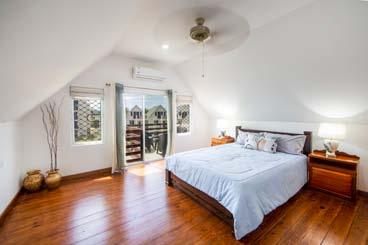


Tobago Properties For Sale Call or WhatsApp (868) 620-4382 / (868) 302-5849 Shazim Ali – Property Developer 5 Bedrooms – Ocean Front TT$2.7m Crown Point 3 Bedroom Condos – TT$1.65m 2 Bedroom Condos – TT$1.35m Shirvan Road
THE BRIX AUTOGRAPH COLLECTION BY MARRIOTT
Elegantly designed and made with the guests’ comfort in mind, the hotel boasts 161 spacious guest rooms and suites. Elevated food and beverage experiences await guests at our fine dining restaurant the Exchange and the Sugar High Rooftop Lounge and Bar.
The BRIX, Human Chemistry in Action.

thebrixtrinidad.com
2-4 Coblentz Avenue, Port of Spain, Trinidad
+1
(868) 612-4000


















































































 Reviews by Nigel A Campbell
Leon foster thomas Calasanitus (Krossover Jazz)
Reviews by Nigel A Campbell
Leon foster thomas Calasanitus (Krossover Jazz)





 Reviews by Shivanee Ramlochan, Book Review Editor
Reviews by Shivanee Ramlochan, Book Review Editor

































































































 Antigua & Barbuda
Antigua & Barbuda













































































